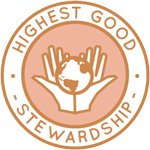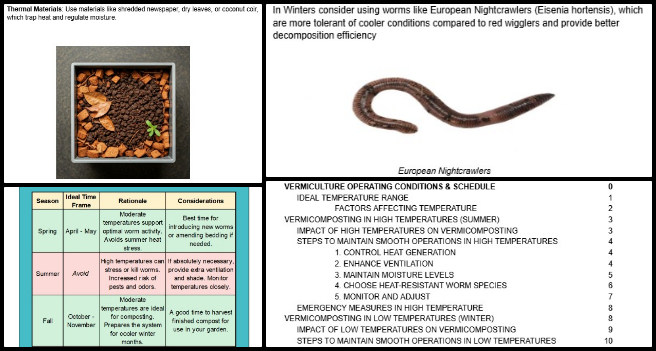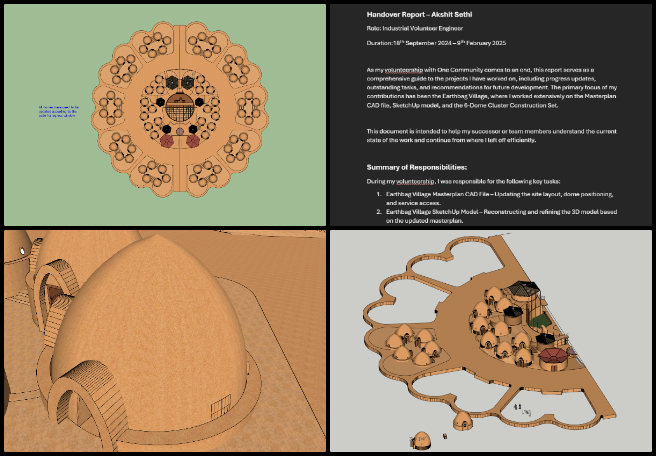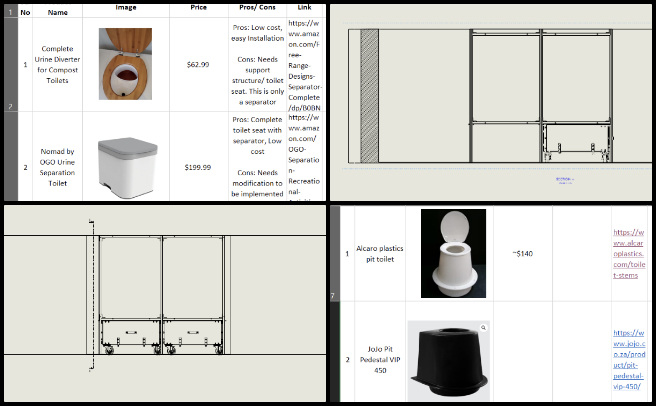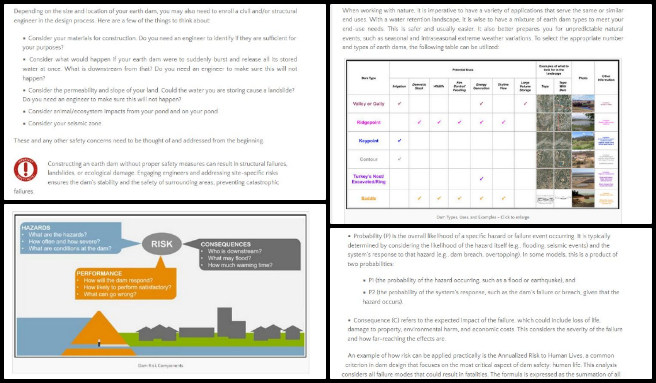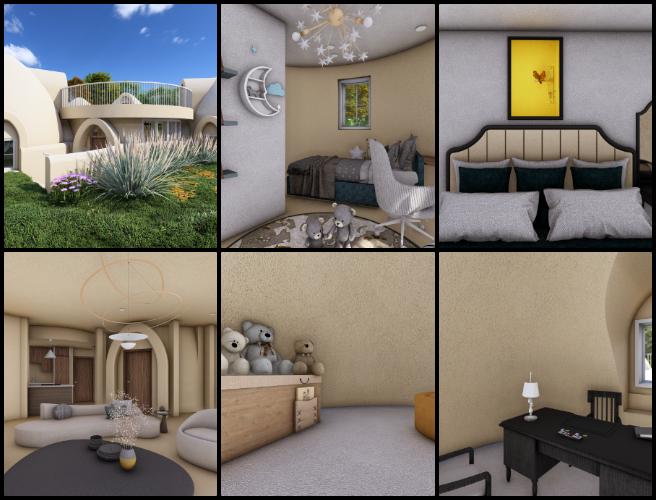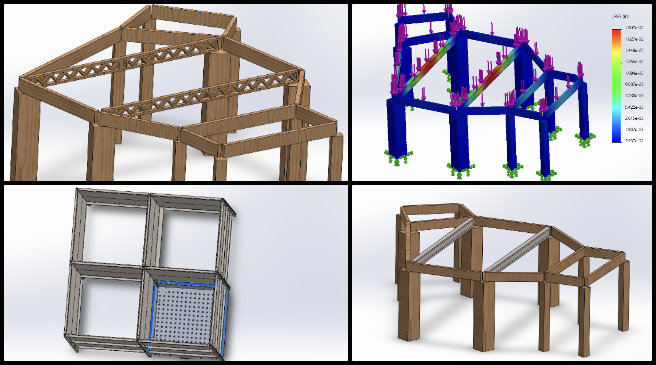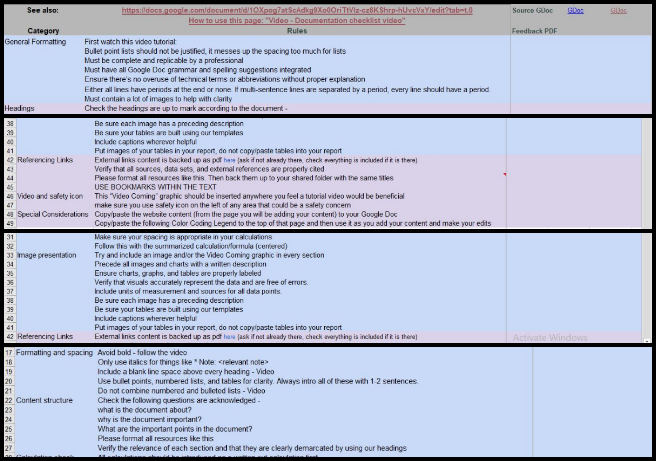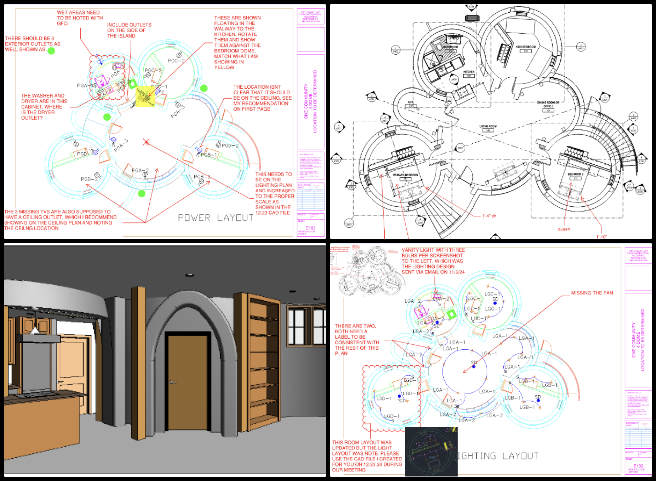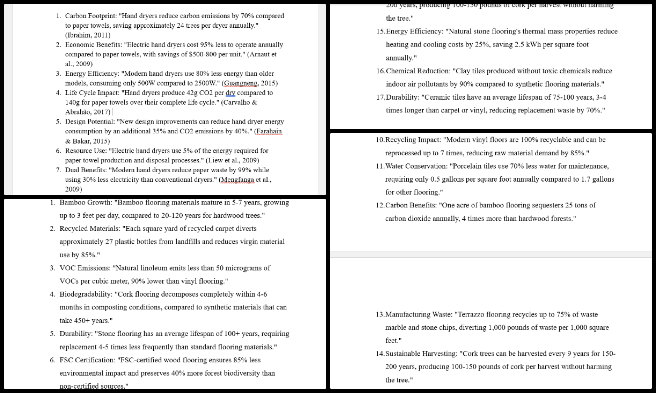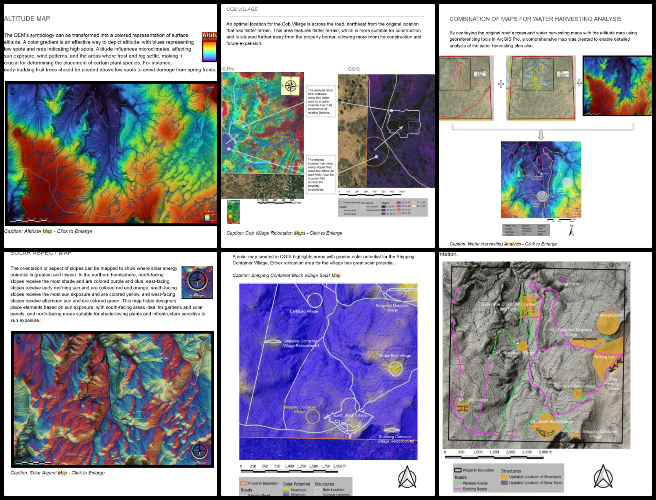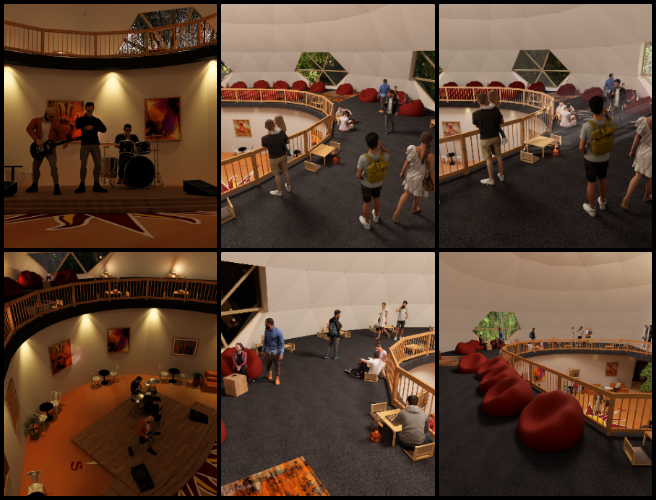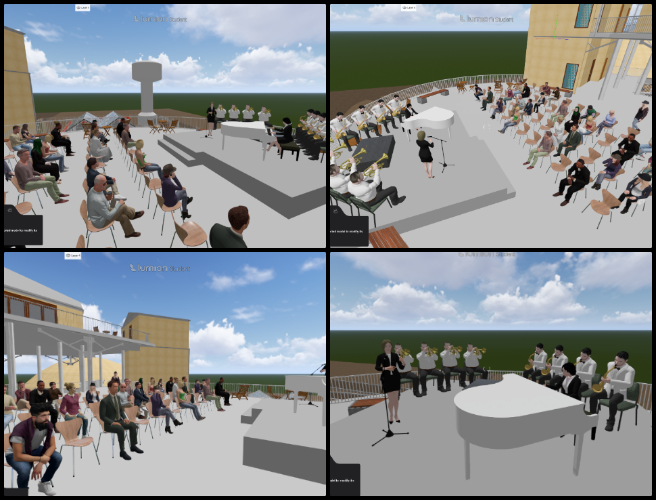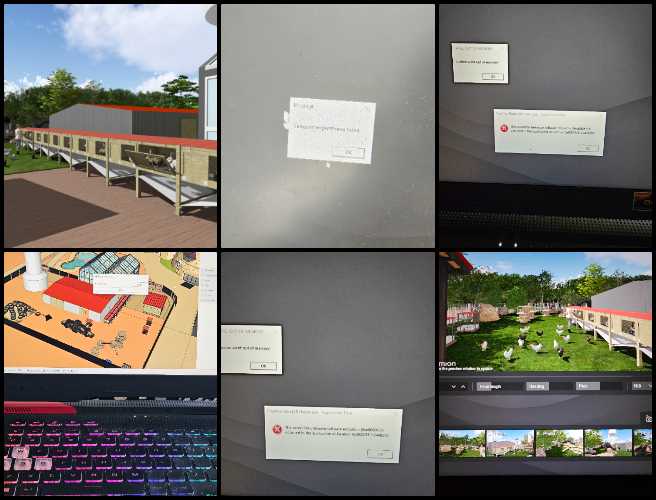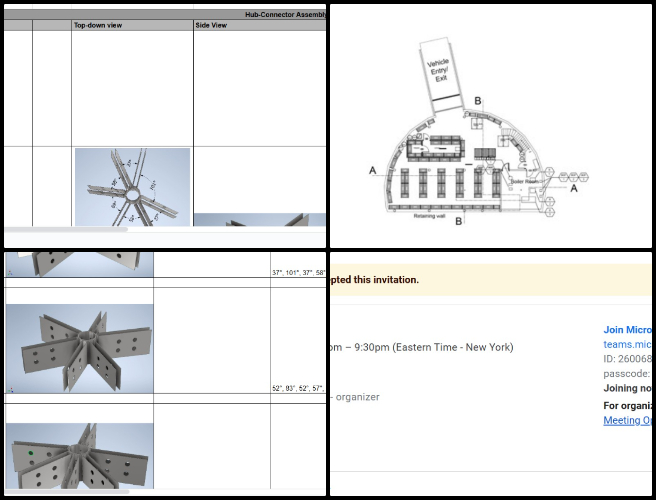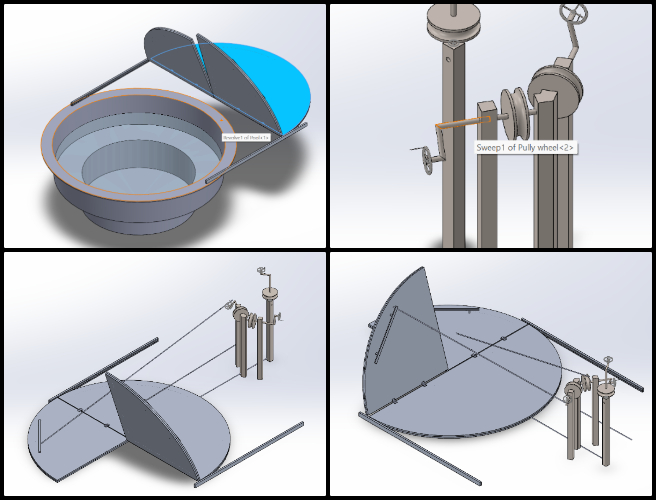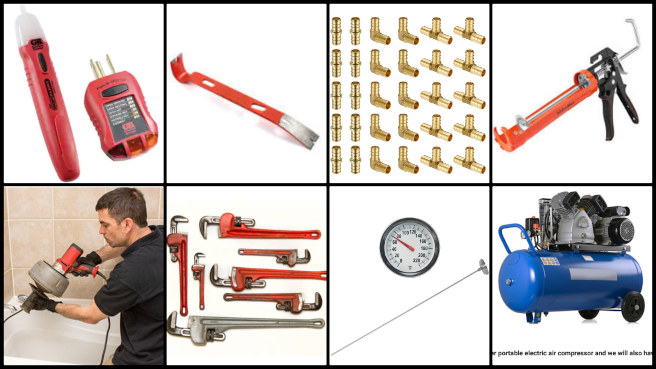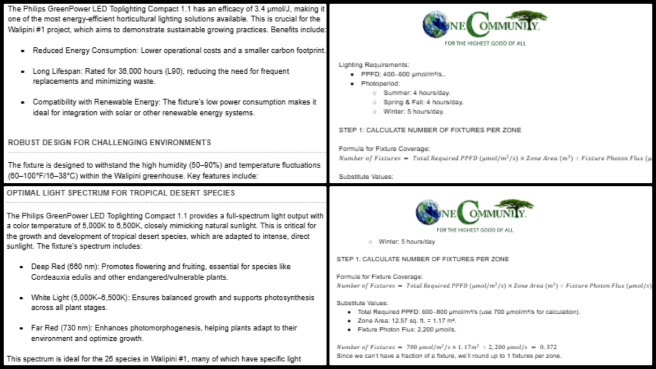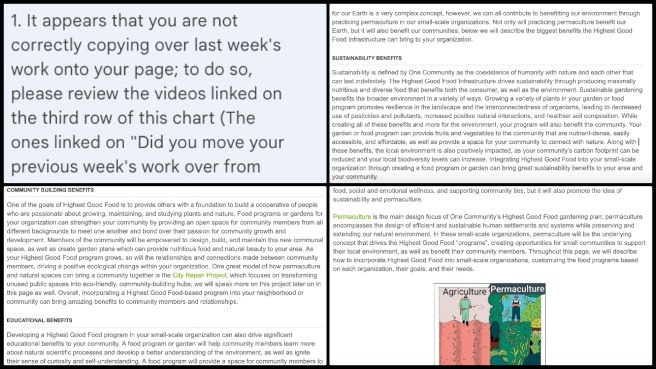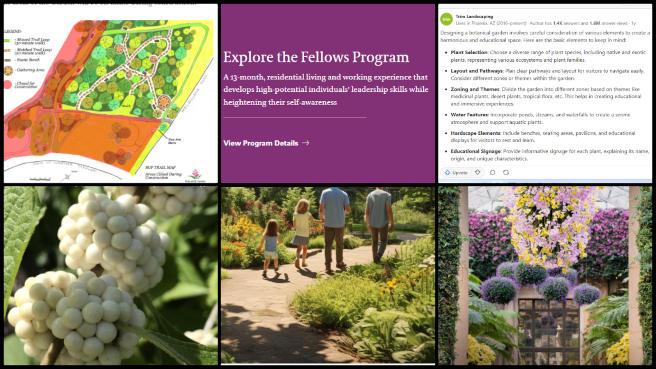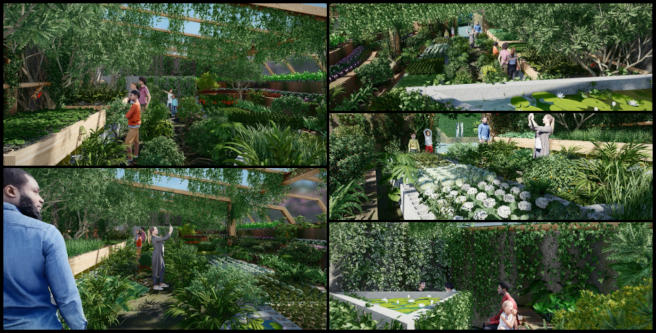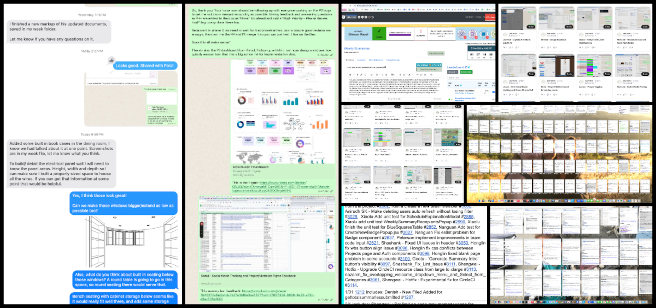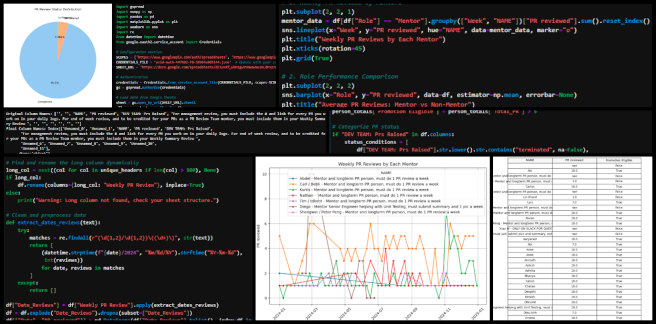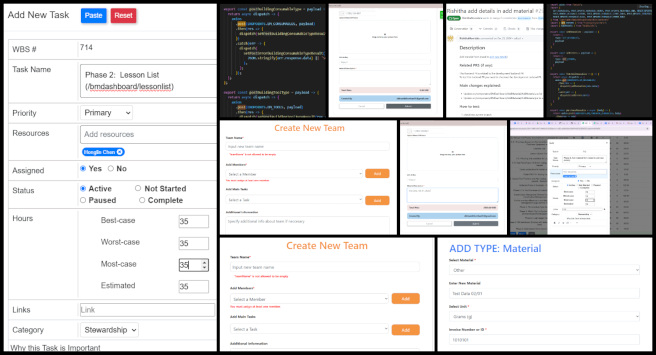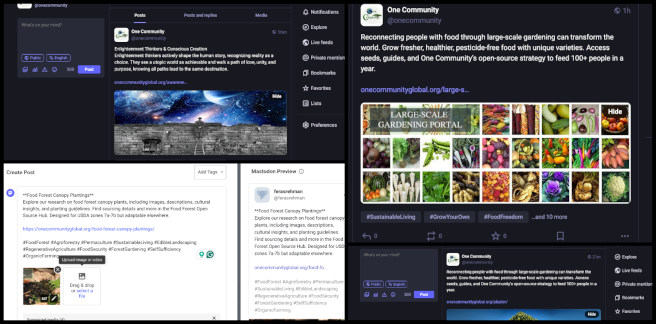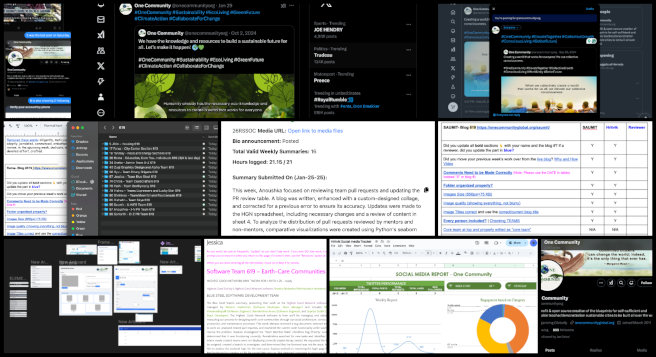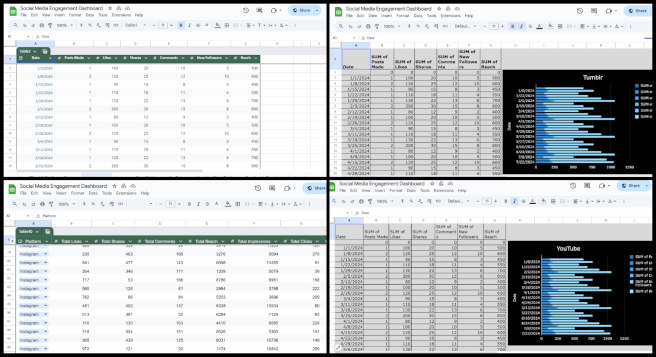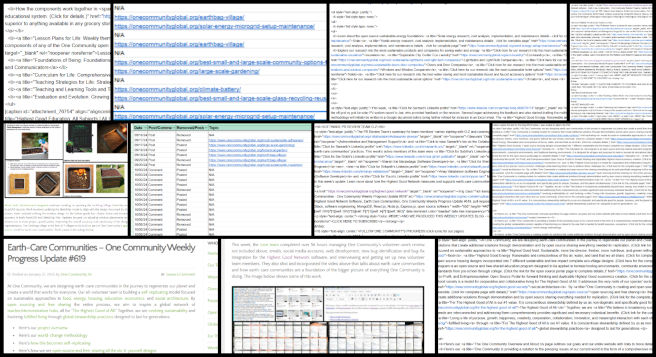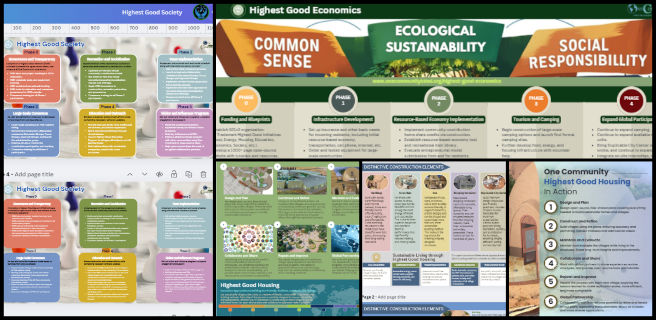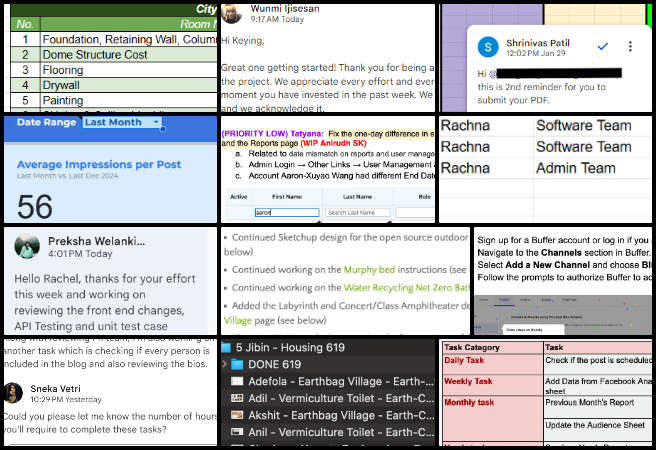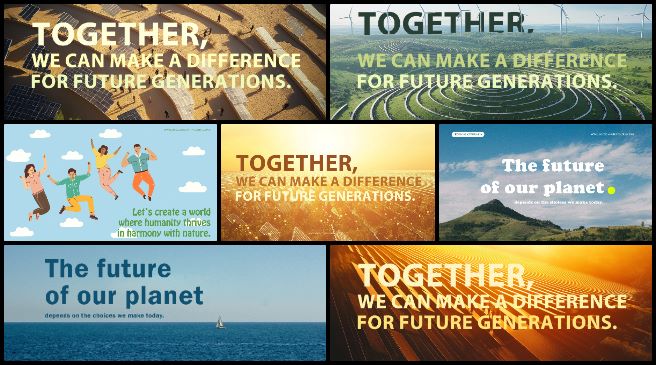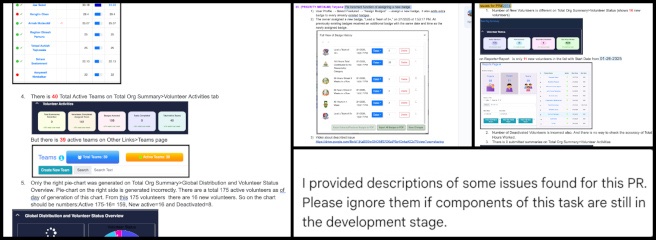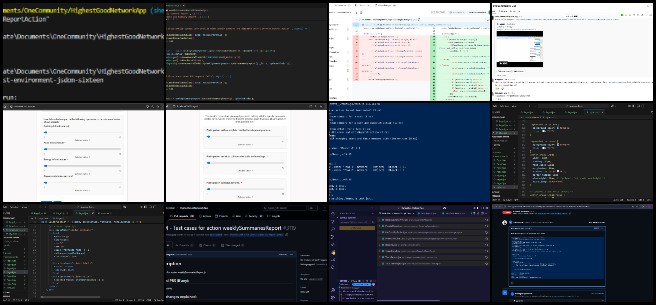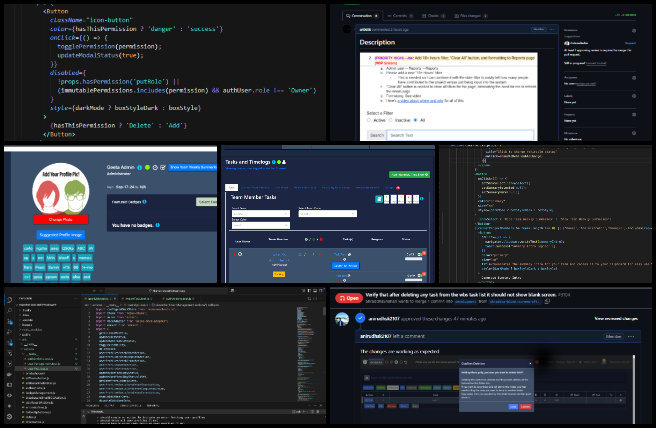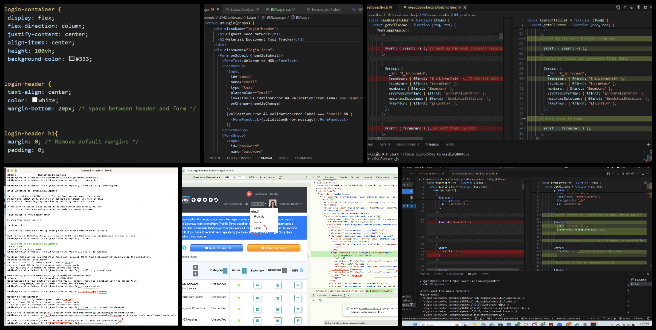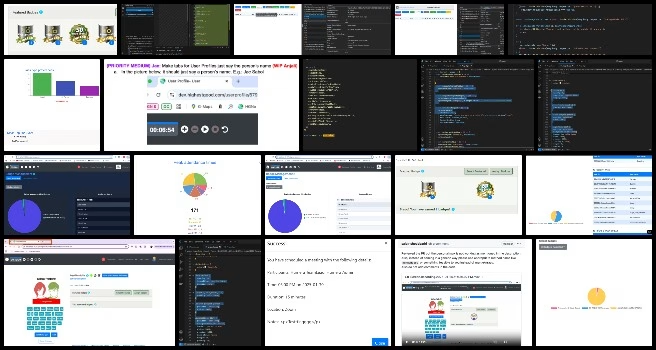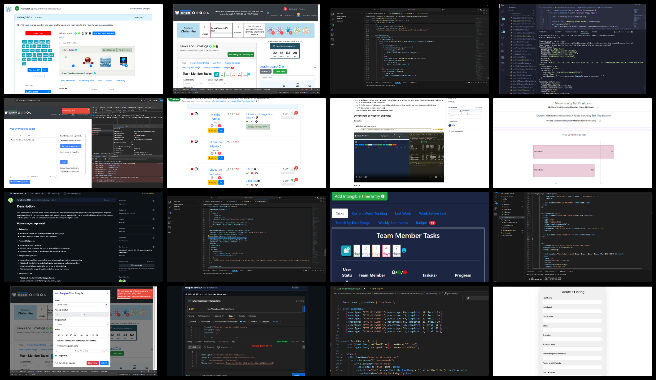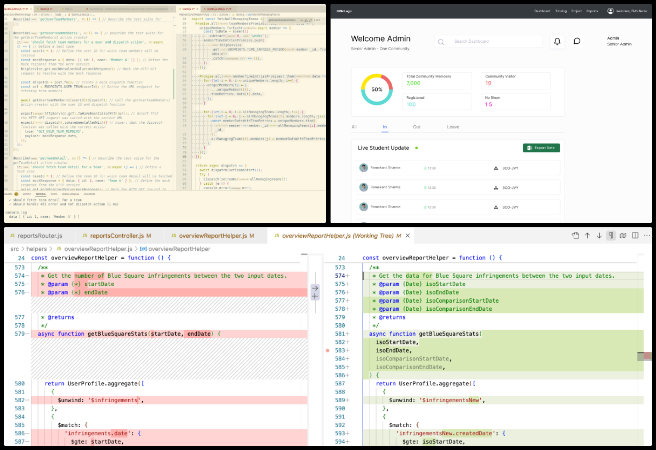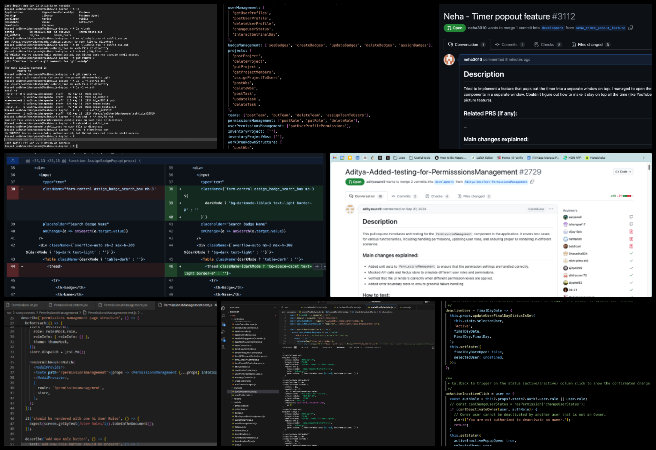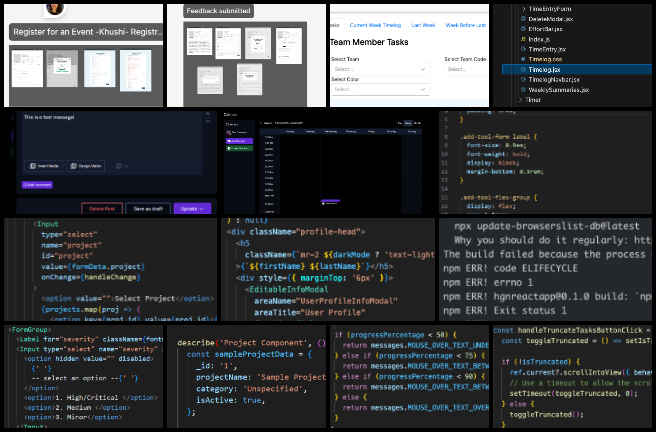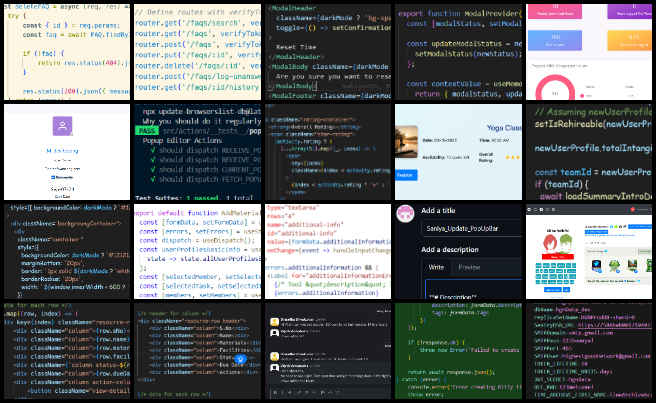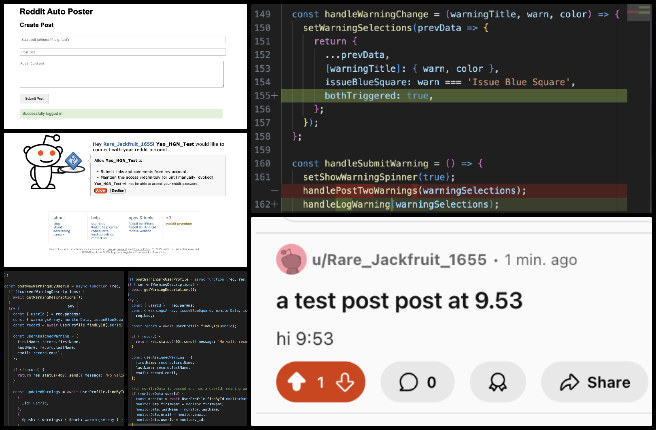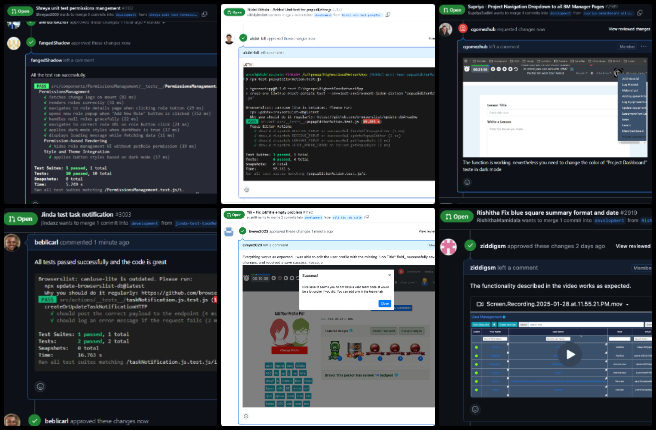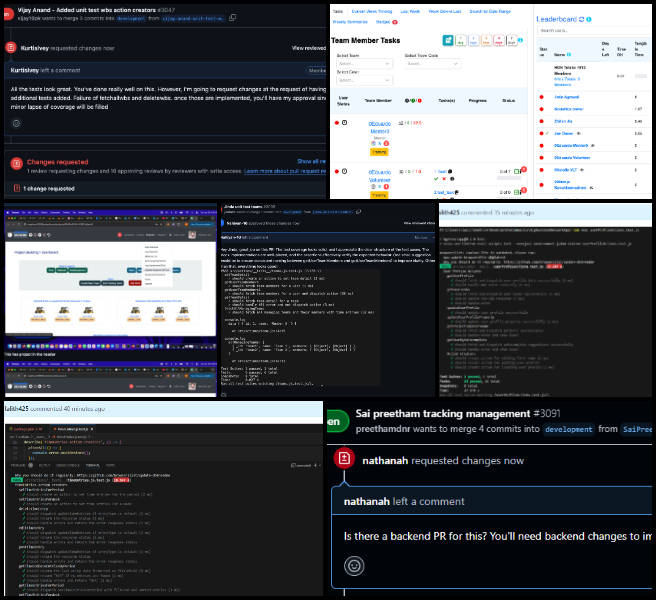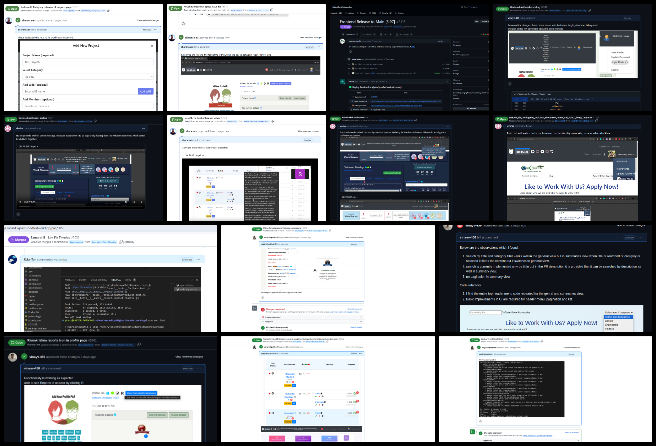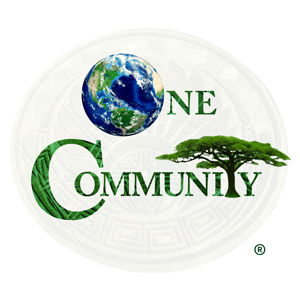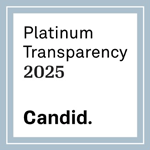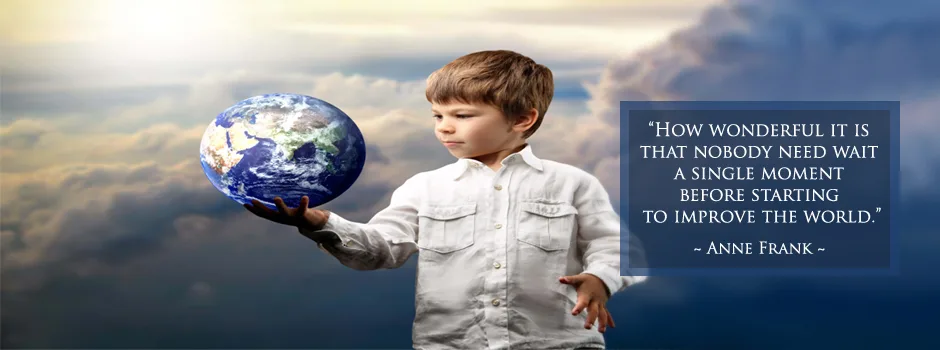
One Community Welcomes Sujith Reddy Sudini to the Software Development Team!
Posted on February 7, 2025 by One Community Hs
One Community welcomes Sujith Reddy Sudini to the Software Team as our newest Volunteer/Consultant!
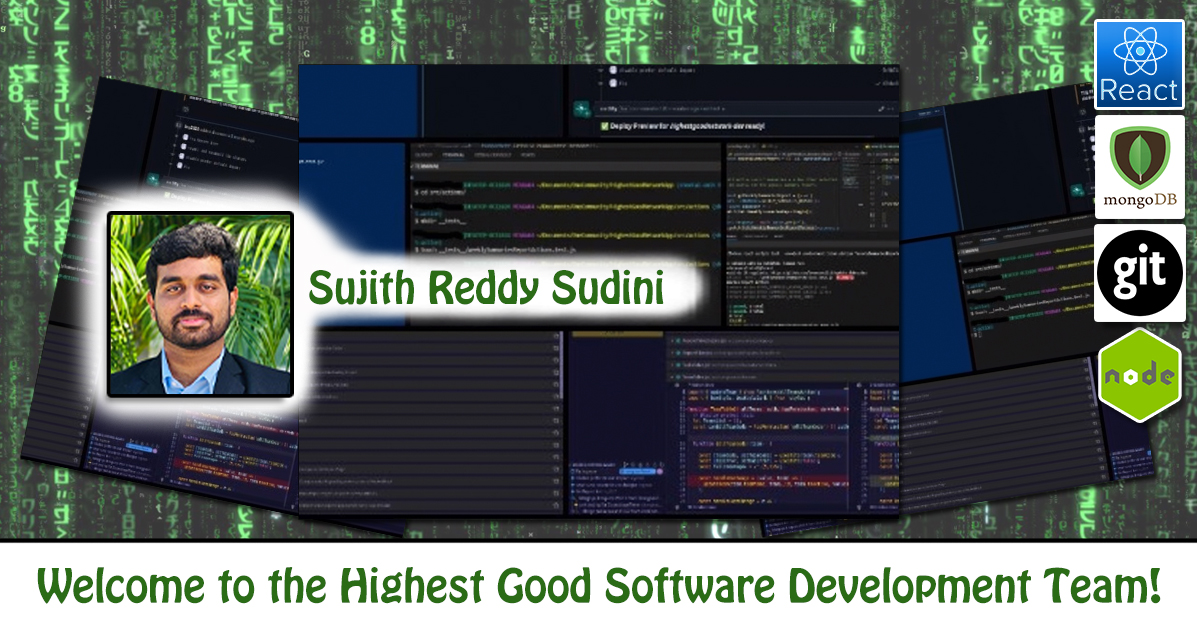
Sujith is an experienced software developer and full stack developer with expertise in JavaScript frameworks such as React.js, Angular, Vue.js, Node.js, and Express.js. He has explored a variety of trending technologies, including web development, data management, cloud computing, artificial intelligence, and the software development lifecycle (SDLC). Skilled in building scalable and secure applications, Sujith focuses on developing robust back-end services and delivering smooth, responsive front-end experiences. With practical experience in cloud technologies—especially AWS—he has successfully deployed microservices-based applications and optimized CI/CD pipelines for efficient, high-quality software releases. As a member of the One Community software team, Sujith has contributed significantly to the Highest Good Network app, creating a front-end Resource Request Form and designing a Resource Management Dashboard that streamlines resource tracking and enhances usability, aligning with One Community’s sustainability mission.
WELCOME TO THE TEAM SUJITH!
FOLLOW ONE COMMUNITY’S PROGRESS (click icons for our pages)
INVESTOR PAGES
GET INVOLVED
One Community Welcomes Shraddha Shahari to the Software Development Team!
Posted on February 7, 2025 by One Community Hs
One Community welcomes Shraddha Shahari to the Software Team as our newest Volunteer/Consultant!
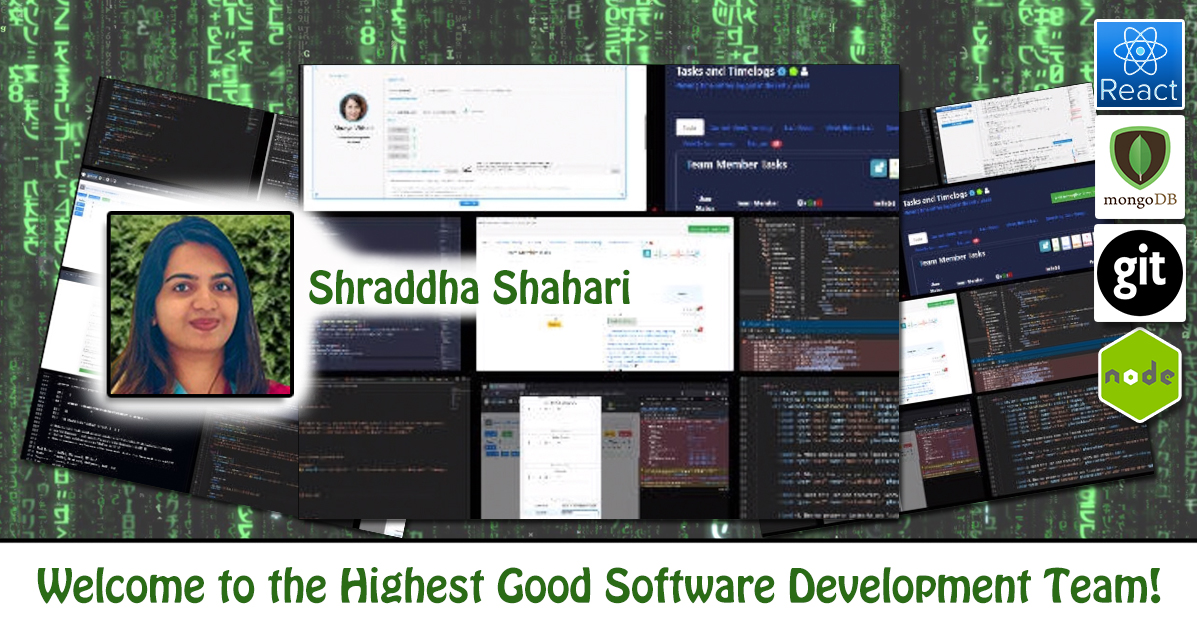
Shraddha is a dynamic and skilled software engineer with over 3 years of experience in the software development life cycle, specializing in designing, developing, and maintaining software applications. She brings expertise in Python, Java, JavaScript (Node.js, React.js), AWS, and PostgreSQL, and has excelled in fast-paced environments like multi-factor authentication services. She has also worked on complex projects, such as house price prediction leveraging AI/ML techniques, showcasing her ability to deliver efficient and effective solutions. As a member of the One Community team, Shraddha is contributing to the development of the open-source Highest Good Network software project and time-tracking software that manages, tracks, and rewards volunteer hours. Known for her commitment to delivering robust and reliable code, Shraddha consistently adds value to every task she undertakes.
WELCOME TO THE TEAM SHRADDHA!
FOLLOW ONE COMMUNITY’S PROGRESS (click icons for our pages)
INVESTOR PAGES
GET INVOLVED
One Community Welcomes Supriya Sudini to the Software Development Team!
Posted on February 6, 2025 by One Community Hs
One Community welcomes Supriya Sudini to the Software Development Team as our newest Volunteer/Consultant!
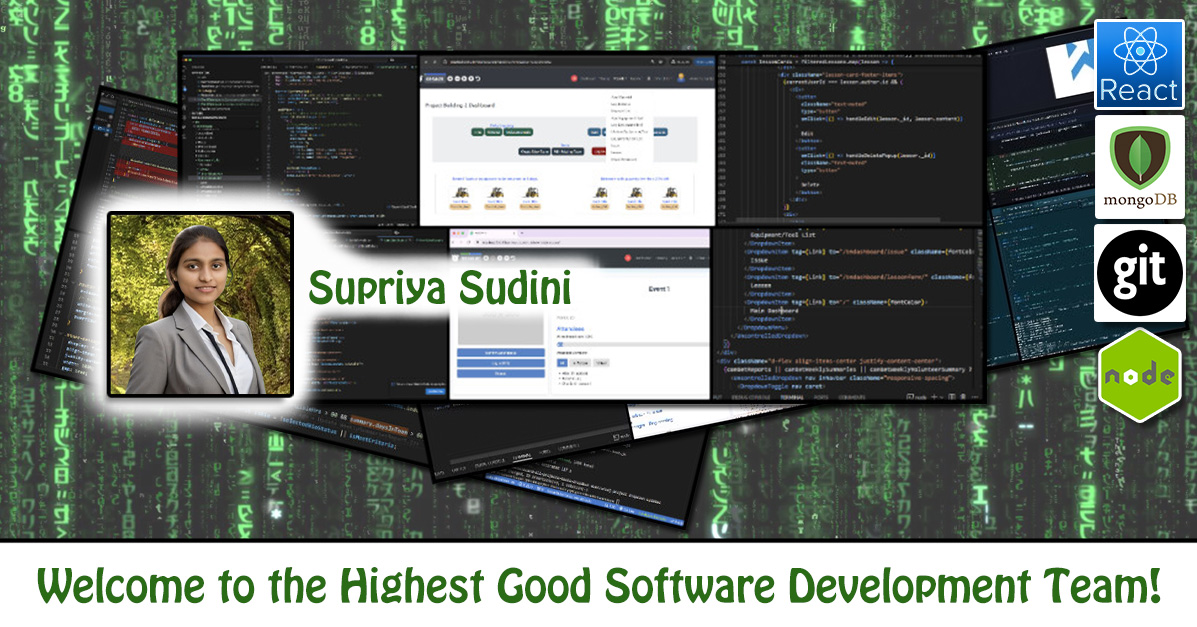
Supriya is a versatile software engineer and Full Stack Developer, who specializes in advanced JavaScript technologies, including React and Redux hooks, fortifying state management and enhancing front-end functionalities. As a member of the One Community team, her skill set extends to NoSQL databases and AWS cloud platforms, which bolster her capabilities in developing scalable and efficient web applications. Recently, Supriya has made significant contributions to the Highest Good Network app by developing a dynamic dropdown menu for the BM Dashboard, designed specifically for project-related sections to improve navigation and user interaction. Additionally, she implemented a custom 404 Not Found page that handles erroneous navigation by redirecting users to a user-friendly error page, ensuring a seamless user experience. Her efforts in refining the application’s CSS have ensured that the dropdown menus are not only functional but also aesthetically pleasing, demonstrating her ability to blend functionality with style. These enhancements have greatly improved system performance and user engagement, underscoring her pivotal role as a member of the One Community team.
WELCOME TO THE TEAM SUPRIYA!
FOLLOW ONE COMMUNITY’S PROGRESS (click icons for our pages)
INVESTOR PAGES
GET INVOLVED
One Community Welcomes Bhavya Prakash to the Software Development Team!
Posted on February 6, 2025 by One Community Hs
One Community welcomes Bhavya Prakash to the Software Development Team as our newest Volunteer/Consultant!
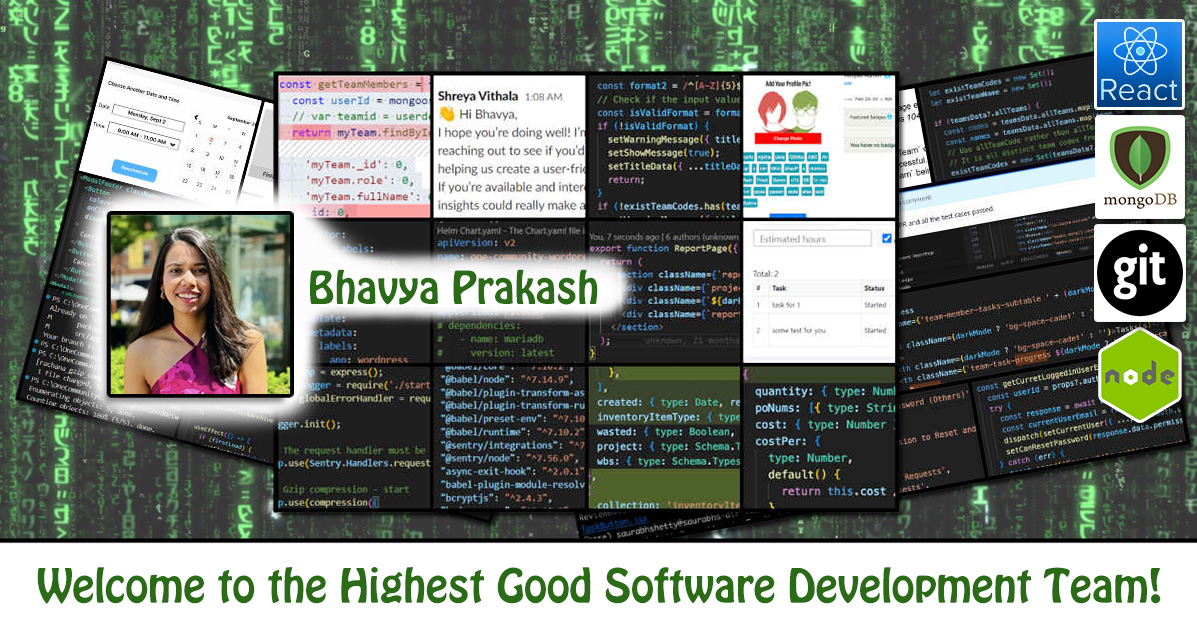
Bhavya is an experienced software engineer specializing in full-stack development and scalable distributed systems. She has over two years of professional experience, along with academic projects focused on building cloud-native web applications and social media platforms. Proficient in Java, JavaScript (Node.js, React.js), AWS, GCP, and PostgreSQL, she excels in designing and optimizing software solutions. As part of the One Community initiative, Bhavya has made impactful contributions to the Highest Good Network project by reviewing pull requests, resolving bugs, and enhancing backend systems with database integrations. Her collaborative mindset and commitment to delivering high-quality solutions have been invaluable to the team.
WELCOME TO THE TEAM BHAVYA!
FOLLOW ONE COMMUNITY’S PROGRESS (click icons for our pages)
INVESTOR PAGES
GET INVOLVED
Thanks for Your Contributions to Our Software Development Team Anoushka Gupta!
Posted on February 6, 2025 by One Community Hs
One Community thanks Anoushka Gupta for her contributions as a Volunteer/Consultant on the Software Development Team!

Anoushka is a highly skilled Software Engineer with a strong background in AI, natural language processing (NLP), cloud technologies and backend development. She holds a Master of Science in Computer Science from New York University. Anoushka has gained valuable experience working on projects that involve machine learning, data pipelines, and cloud-based applications. She has designed and deployed AI systems to enhance accuracy and efficiency, developed scalable solutions using cloud platforms, and contributed to improving software performance. As a member of the One Community team, Anoushka has contributed to the Highest Good Network by working on PR reviews, adding new features, and fixing bugs. She has resolved issues like bugs in the badge management system and added new functionalities, such as implementing new APIs for the application and job search pages.
WELCOME TO THE TEAM ANOUSHKA!
FOLLOW ONE COMMUNITY’S PROGRESS (click icons for our pages)
INVESTOR PAGES
GET INVOLVED
Ecological Models for Thriving – One Community Weekly Progress Update #620
Posted on February 3, 2025 by One Community Hs
At One Community, we are committed to creating ecological models for thriving by implementing sustainable approaches to food, energy, housing, education, and economics. Our all-volunteer team is developing a self-replicating model designed to support global stewardship and fulfilled living. By open sourcing and free sharing every aspect of our work, we aim to create a worldwide network of teacher/demonstration hubs focused on regenerating our planet and evolving sustainability for “The Highest Good of All“.
- Here’s our project overview
- Here’s our world-change methodology
- Here’s how this becomes self-replicating
- Here’s how we are open source and free-sharing all the do-it-yourself designs
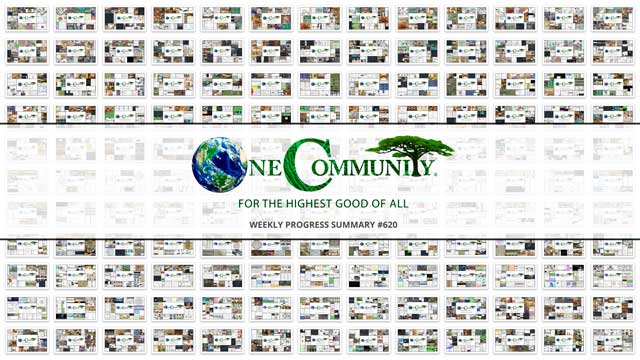
OUR MAIN OPEN SOURCE HUBS
Click on each icon to be taken to the corresponding Highest Good hub page.
One Community’s physical location will forward this movement as the first of many self-replicating teacher/demonstration communities, villages, and cities to be built around the world. This is the February 3rd, 2025 edition (#620) of our weekly progress update detailing our team’s development and accomplishments:
Ecological Models for Thriving
One Community Progress Update #620
DONATE | COLLABORATE | HELP WITH LARGE-SCALE FUNDING
CLICK HERE IF YOU’D LIKE TO RECEIVE AN EMAIL EACH WEEK WHEN WE RELEASE A NEW UPDATE
YOU CAN ALSO JOIN US THROUGH SOCIAL MEDIA
ONE COMMUNITY WEEKLY UPDATE DETAILS
HIGHEST GOOD HOUSING PROGRESS
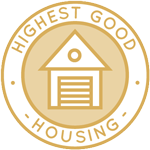 One Community is creating ecological models for thriving through Highest Good housing that is artistic and beautiful, more affordable, more space efficient, lasts longer, DIY buildable, and constructed with healthy and sustainable materials:
One Community is creating ecological models for thriving through Highest Good housing that is artistic and beautiful, more affordable, more space efficient, lasts longer, DIY buildable, and constructed with healthy and sustainable materials:
- Learn about: Our Upcoming Crowdfunding Campaign
- Learn about the different village models: 7 Sustainable Village Models
- Visit the open source portals for the first two: Earthbag Village OS Hub | Straw Bale Village OS Hub
This week, Adefola (Fola) Madehin (Electrical Design Specialist) continued his work with Earthbag Village electrical designs. Fola completed the socket and panel layout for the Earthbag Village project. Receptacles were placed in the bedrooms, bathroom, and living room, with the distribution panel installed in the living room on the first floor. Air-conditioning sockets were connected directly to the panel, each with its own breaker. Ring circuits were connected in a loop, each also with its own breaker. The Earthbag Village is the first of 7 to be built as the housing component of One Community’s open source model for ecological models for thriving. See some of his work in the collage below.
Adil Zulfiquar (Engineer) continued working on the Vermiculture Toilet engineering designs. Final edits were made to the vermiculture transport report in preparation for publication. The vermiculture operating conditions and schedule report was updated with the latest feedback. New content was added to address similarities and provide recommendations related to the vermiculture design, and additional pictorial representations were included to improve clarity and understanding. The Earthbag Village, the first of seven planned villages, serves as the initial housing component within One Community’s open source model for ecological models for thriving. See below for some of the pictures related to work.
Akshit Sethi (Architectural Designer) continued working on updating the Earthbag Village SketchUp and AutoCAD layouts. Akshit updated the SketchUp model and CAD file and added detailed notes to the handover report to support a smooth transfer of information. The updates were focused on improving clarity and organization to help the next team understand and build upon the existing work. As the first of seven villages in One Community’s open source plan for ecological models for thriving, the Earthbag Village represents the housing element. See his work in the collage below.
Anil Karathra (Mechanical Engineer) continued advancing the engineering and design of the Vermiculture Toilet for the Earthbag Village project. Research was done on hardware options for the vermiculture toilet, including toilet seat solutions and a knockdown mechanism for composting material. Tasks were assigned during the weekly team meeting, and work on the knockdown mechanism design continued. 2D drawings with alternate views of the vermiculture toilet were created. Screenshots of previous work were uploaded to Dropbox, and the weekly summary was compiled. This commitment to ecological models for thriving drives the development of innovative, eco-friendly solutions that balance environmental responsibility with high standards of functionality. See below for pictures related to this work.
Charles Gooley (Web Designer) continued working on the Aircrete Engineering and Research: Compression Testing, Mix Ratios, R-value, and More page. Charles worked on the Aircrete Engineering and Research Compression Testing, Mix Ratios, and R-Value, addressing comments on the page and updating the tables of contents. The tools in the Materials section still need to be added to the Master Tools and Equipment page for linking, but the page is otherwise ready for final review. Work continued on the Open Source DIY Earth Dam Design & Construction for Water Retention, Pond & Lake Creation page, with additions made and comments addressed. Aircrete is an alternative being explored for the Earthbag Village, a foundational part of One Community’s open-source model for ecological models for thriving. Take a look at some of the work in the images below.
Faeq Abu Alia (Architectural Engineer) continued his work on the Earthbag Village 4-dome home renders. He refined the interior layout and finishes for the first room, second and third bedrooms, kitchen, jacuzzi area, and living room based on feedback to improve functionality, aesthetics, and coherence. The exterior modeling was further adjusted to align with the overall design concept. Walkthrough videos were rendered, showcasing updates to the first room, the living room, the dining room, the second bedroom, and the third bedroom. The Earthbag Village represents a fundamental element of One Community’s open-source approach, dedicated to the mission of ecological models for thriving. View examples of this work in the pictures provided below.
Karthik Pillai (Mechanical Engineer) continued helping finish the Vermiculture Toilet engineering and helping with the Earthbag Village 4-dome home roof plan. Karthik worked on the four-dome cluster roof design, assessing the feasibility of a truss beam and a steel I-section beam as structural alternatives. Research on the internal framing of the truss beam is ongoing. The steel I-section beam was found to provide adequate support, but a cost analysis is needed to compare it with wood. For the vermiculture toilet design, structural work identified areas requiring design modifications, and specific issues were noted for discussion with the team to evaluate potential solutions. The Earthbag Village is the first of 7 to be built as the housing component of One Community’s open source model for ecological models for thriving. See the work in the collage below.
Manjiri Patil (Mechanical Design Engineer) continued helping to complete the Vermiculture Toilet engineering and designs. Manjiri developed an Excel-based checklist to systematically verify that all project documents meet the required standards, aiming to improve accuracy and compliance. She also worked on the Hub Connectors for the Dome simulation, creating detailed 2D drawings to support precise design, assembly, and integration, which will enhance project efficiency and workflow. This approach for ecological models for thriving supports the development of innovative solutions that are both environmentally friendly and effective. See below for pictures related to this work.
Michaela Silva (Architect) continued working on the interior details for the Earthbag Village 4-dome home design. Michaela reviewed and marked up the updated electrical drawings for the 4-dome structure provided by Fola. She also worked on the architectural model, focusing on modeling built-in bookcases in the dining room. Michaela created camera views of the dining room built-ins for design approval prior to starting the detailing work. As the first of seven villages in One Community’s open source plan for ecological models for thriving, the Earthbag Village represents the housing element. See her work in the collage below.
Vimarsh Acharya (Engineering Manager and Technical Reviewer) continued working on identifying sustainability-related arguments covering the Highest Good Lifestyle Considerations and sourcing quality research to support each one. Vimarsh completed the tagline with numbers task, aiming to improve the clarity and impact of statements by integrating numerical data. This approach ensured that the information presented was credible and easily understandable, backed by measurable values. In addition to finalizing the tagline task, Vimarsh collaborated with Jae to finalize key documents, providing input to enhance their accuracy, coherence, and completeness. The focus was on refining content to improve its quality and effectiveness, with particular attention to incorporating relevant data and insights. The One Community model, which combines forward-thinking education with sustainably built classrooms like this, is an excellent example of ecological models for thriving. See the collage below for his work.
DUPLICABLE CITY CENTER PROGRESS
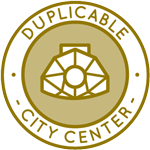 One Community is creating ecological models for thriving through a Duplicable and Sustainable City Center that is LEED Platinum certified/Sustainable, can feed 200 people at a time, provide laundry for over 300 people, is beautiful, spacious, and saves resources, money, and space:
One Community is creating ecological models for thriving through a Duplicable and Sustainable City Center that is LEED Platinum certified/Sustainable, can feed 200 people at a time, provide laundry for over 300 people, is beautiful, spacious, and saves resources, money, and space:
- Learn about this building and it’s function: Duplicable City Center Open Source Hub
Arnob Mutsuddi (Mechanical Engineer) continued working on Duplicable City Center structural engineering model and details. His work continued on the dimensions and analysis of the BOM spreadsheet, with relevant files uploaded throughout the process. The spreadsheet was completed, and the final files were uploaded. Handover documents were updated with hyperlinks attached and then submitted. Also, completed tasks and next steps were included in the handover document. The Duplicable City Center is a foundational part of One Community’s open-source model, which excels in the mission of ecological models for thriving. This approach is integral to their mission of ecological models for thriving through innovative and scalable solutions. See some of this work in the pictures below.
Chris Blair (GIS Technician/Horticulturist) continued working with GIS data as part of One Community’s Permaculture Design which includes the location of the Duplicable City Center. He completed the final draft of the GIS content for the Permaculture Design webpage, adding captions, linking images, and correcting minor grammatical errors. He also updated the master plan by adding additional roads to connect villages to the main road. Within One Community’s open-source framework, the Duplicable City Center plays a central role in ecological models for thriving. The images below showcase some of this work.
Jason Bao (Architectural Designer) continued working on producing renders for the Duplicable City Center library. Render adjustments were made based on Jae’s requests, and the lighting for the second-floor zone of the social dome was finalized. Three lighting options were rendered and sent for feedback, and after receiving a response, the final lighting settings were confirmed. Adjustments were made to table lamps, and these changes were implemented into the Lumion model. A mood-lighting version of the social dome was set up, and assets for musicians and a stage were sourced, packaged in SketchUp, and integrated into Lumion. A first batch of test renders for the mood lighting setup was produced and sent to Jae for feedback. The Duplicable City Center is a foundational part of One Community’s open-source model, which excels in ecological models for thriving. This approach is integral to their mission of ecological models for thriving through innovative and scalable solutions. See some of this work in the pictures below.
Mohammed Maaz Siddiqui (Architect) continued working on the cupola renders for the Duplicable City Center project. He worked on developing and rendering the wedding and exercise scenes on the sun deck for the final output. Following this, he created a new scene on the same sun deck, depicting a music event to illustrate the range of activities the space can accommodate. This involved adding a stage with musicians and arranging an audience seated in chairs. Within One Community’s open-source framework, the Duplicable City Center plays a central role in the mission of ecological models for thriving. The images below showcase some of this work.
Nimika Devi (Architect) continued her contributions to the landscape design and development of the Duplicable City Center‘s urban farm. Her work involved importing the project file from SketchUp to Lumion for rendering and visualization. Efforts were directed toward re-rendering the barn area after technical issues in the software prevented the previously edited renders from being saved. Adjustments were made to ensure the rendering process proceeded without further disruptions, addressing any compatibility or performance issues between the software platforms. The Duplicable City Center is central to One Community’s open-source mission of creating ecological models for thriving. The images below showcase some of this work.
Rachan Rao (Project Manager) continued working on the cost analysis for Off-Grid energy implementation in the Highest Good energy project. He worked with the Duplicable City Center team to gather their updates. He also coordinated with Arnob to hand over his tasks to Manjiri and dedicated time to bringing Manjiri up to speed on the project’s progress and the remaining work. Additionally, Rachan interviewed potential candidates who could contribute to the project and the organization’s objectives. As part of One Community’s open-source approach, the Duplicable City Center is essential for developing ecological models for thriving. The images below showcase some of this work.
Sanket Basannavar (Mechanical Engineer) continued working on the Duplicable City Center spa cover as part of the City Center Natural Pool and Eco-spa Designs. A new design of the spa pool was completed, including the assembly of the spa cover, to enable better analysis of heat flux changes and study heat or energy loss due to the cover design. A pulley system was developed to assist with the opening of the spa cover panels. Additionally, lift-assist hinges were designed to reduce the effort required to lift the panels, cutting the necessary effort by approximately 70%. One Community’s open-source framework positions the Duplicable City Center as key to its pursuit of ecological models for thriving. The images below showcase some of this work.
HIGHEST GOOD FOOD PROGRESS
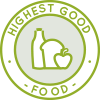 One Community is creating ecological models for thriving through Highest Good food that is more diverse, more nutritious, locally grown and sustainable, and part of our open source botanical garden model to support and share bio-diversity:
One Community is creating ecological models for thriving through Highest Good food that is more diverse, more nutritious, locally grown and sustainable, and part of our open source botanical garden model to support and share bio-diversity:
- Learn about the structures: Hoop House Hub | Aquapini & Walipini Open Source Hub
- See what we’ll be growing: Gardens & Hoop Houses | Large-scale Structures | Food Forest | TA
This week, the core team organized and cross-referenced tool list categories and completed the Aquapini/Walipini, Tools, Equipment, and Materials/Supplies list. Since it has similar requirements to the Tropical Atrium, it is now referenced on the master list. They also added a generator and a power plumber’s snake, marking the completion of the initial rough draft. The Highest Good Food initiative is a key component of One Community’s open source plans, focused on ecological models for thriving, and exemplifies the organization’s commitment through innovative design and implementation. Below are some of the images showcasing this work.
Jay Nair (BIM Designer) continued working on Aquapini and Walipini Planting and Harvesting lighting and HVAC design. He recalculated the lighting energy requirements for the different zones in Walipini 1 based on the Philips GreenPower LED Toplighting Compact fixture. The updated calculations and detailed explanations outlining the selection process were added to the document. The reasoning included factors such as energy efficiency, suitability for plant growth, and alignment with the project’s sustainability goals. The Highest Good Food initiative, a key part of One Community’s open source plans, demonstrates its commitment to ecological models for thriving through innovative design and implementation. Below are some of the images showcasing this work.
Jessica Fairbanks (Administrative Assistant) continued working on her regular administrative tasks, including reviewing the summaries of team members and creating a collage of their work. She also provided feedback and support on the work of several fellow administrators. Jessica scheduled and carried out an interview with a potential volunteer and shared notes with the Hiring Team. Additionally, she began making final edits to the integration of Highest Good Food into small-scale organizations in preparation for a final review. One Community’s open source plans include the Highest Good Food initiative, which focuses on ecological models for thriving and showcases the organization’s commitment via innovative design and implementation. Her contributions are highlighted in the collage below.
Mary Nelson (Landscape Planner) continued researching the Botanical Garden tutorial. She focused on studying various botanical garden designs and layouts to develop a general plan that includes key attributes while allowing flexibility for site-specific adaptations. She concluded the week by beginning work on a general botanical garden map to be incorporated into One Community’s existing tutorial. The Highest Good Food initiative is essential to One Community’s open source plans, focused on ecological models for thriving, and exemplifies the organization’s commitment through innovative design and implementation. Her contributions are highlighted in the collage below.
Silin Wang (Landscape Designer) continued rendering work for Aquapini and Walipini Planting and Harvesting #2: Tropical Moist House. She optimized lighting effects and rendered the final animation, presenting the entertainment space, materials, textures, design, and planting details from multiple perspectives to illustrate the intended tropical greenhouse environment. She also organized previous work and began writing the final report. Focused on ecological models for thriving, the Highest Good Food initiative is a key component of One Community’s open source plans, exemplifying its commitment with innovative design and implementation. Her contributions are highlighted in the collage below.
Tanmay Koparde (Industrial Engineer And Team Administrator) continued working on the Menu Supply Chain and Shopping Plan, Cost Analysis, and Food Procurement and Storage Plan to streamline organizational workflows and enhance efficiency. This week, he focused on ensuring the alignment of fonts and headlines in his Food Procurement and Storage Plan case review to present a polished and professional document. He worked on finding AI-generated images that effectively represent food procurement concepts and sought precise calculations to enhance and optimize the procurement strategy for improved efficiency and cost-effectiveness. Updates were made to optimize procurement processes, improve cost efficiency, and refine supplier evaluations to align with overall strategic goals for better operational outcomes. Additionally, he reviewed Preksha’s training week and provided suggestions on her training work for the admin. A key component of One Community’s open source plans is the Highest Good Food initiative, which emphasizes ecological models for thriving and reflects the organization’s commitment to innovative design and implementation. See his work in the collage below.
Vatsal Tapiawala (Mechanical Engineer) continued working on the structural analysis of Walipini 1. He refined the geometry to ensure accuracy, generated the mesh with appropriate element sizes, and defined the necessary boundary conditions. After running the analysis, he reviewed the results to assess the structural performance. He then compiled the findings into a report and submitted it for review. The Highest Good Food initiative, central to One Community’s open source plans for ecological models for thriving, illustrates the organization’s commitment through innovative design and implementation. See his work in the collage below.
HIGHEST GOOD ENERGY PROGRESS
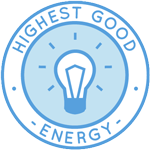 One Community is creating ecological models for thriving through Highest Good energy that is more sustainable, resilient, supports self-sufficiency and includes solar, wind, hydro and more:
One Community is creating ecological models for thriving through Highest Good energy that is more sustainable, resilient, supports self-sufficiency and includes solar, wind, hydro and more:
- Learn about the open source sustainable-energy foundations: Solar, Hydro, and Wind
- Explore our research into the most sustainable products and companies for saving water and energy: Insulation, Eco-laundry, Lightbulbs and Light Bulb Companies, Doors and Door Companies, Windows and Window Companies, Toilets, Faucets and Faucet Accessories, Urinals, and more.
This week, Muhammad Sarmad Tariq (Electrical Engineer) wrote the methodology for calculating the profit of a grid-tie versus off-grid solar PV system. The methodology was initially drafted in a Google document and has been refined for use in an Excel sheet. It includes calculations for savings for each system, energy costs for deficient units, investment costs, and battery replacement costs. The Highest Good Energy initiative is a key component of One Community’s open-source plans, focused on ecological models for thriving, and exemplifies the organization’s commitment through innovative design and implementation. See his work in the collage below.
HIGHEST GOOD EDUCATION PROGRESS
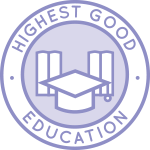 One Community is creating ecological models for thriving through Highest Good education that is for all ages, applicable in any environment, adaptable to individual needs, far exceeds traditional education standards, and more fun for both the teachers and the students. This component of One Community is about 95% complete with only the Open Source School Licensing and Ultimate Classroom construction and assembly details remaining to be finished. We’ll report on the final two elements to be finished as we develop them. With over 8 years of work invested in the process, the sections below are all complete until we move onto the property and continue the development and open sourcing process with teachers and students – a development process that is built directly into the structure of the education program and everything else we’re creating too:
One Community is creating ecological models for thriving through Highest Good education that is for all ages, applicable in any environment, adaptable to individual needs, far exceeds traditional education standards, and more fun for both the teachers and the students. This component of One Community is about 95% complete with only the Open Source School Licensing and Ultimate Classroom construction and assembly details remaining to be finished. We’ll report on the final two elements to be finished as we develop them. With over 8 years of work invested in the process, the sections below are all complete until we move onto the property and continue the development and open sourcing process with teachers and students – a development process that is built directly into the structure of the education program and everything else we’re creating too:
- Program Overview: Education Open Source Hub
- How the components work together in designing human orchestrated eco-abundance: How to use the Education for Life Program
- Lesson Plans for Life – Lesson Plans How-to
- Foundations of Outstanding Leaders, Teachers, and Communicators
- Curriculum for Life
- Teaching Strategies for Life
- Learning Tools and Toys for Life
- Evaluation and Evolution
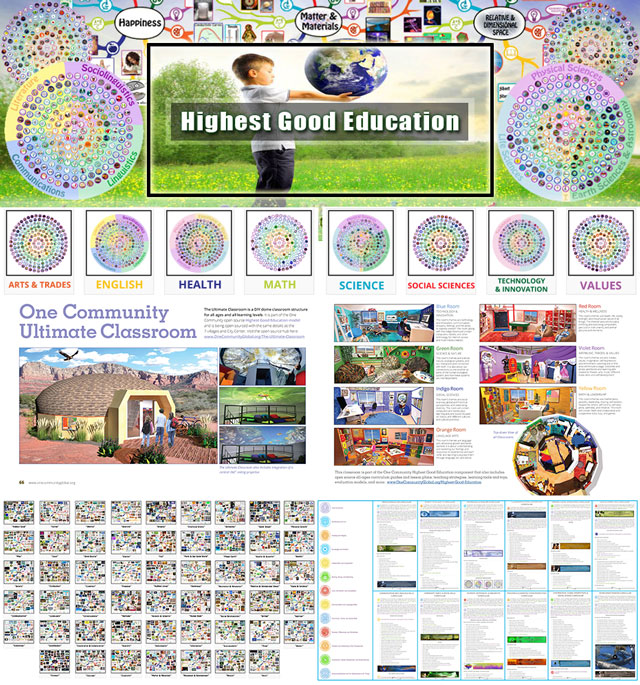
Highest Good Education: All Subjects | All Learning Levels | Any Age – Click image for the open source hub
HIGHEST GOOD SOCIETY PROGRESS
 One Community is creating ecological models for thriving through a Highest Good society approach to living that is founded on fulfilled living, the study of meeting human needs, Community, and making a difference in the world:
One Community is creating ecological models for thriving through a Highest Good society approach to living that is founded on fulfilled living, the study of meeting human needs, Community, and making a difference in the world:
- Read the Highest Good society overview: Highest Good Society
- Learn about the model for fulfilled living and sharing: A Day in the Life
- Learn about the 4 economic models: RBE | For-profit | Non-profit | Entrepreneurship
- Learn about our open source community collaboration and management software: The Highest Good Network
This week, the core team completed over 47 hours managing One Community’s volunteer-work review not included above, emails, social media accounts, web development, new bug identification and bug-fix integration for the Highest Good Network software, and interviewing and getting set up new volunteer team members. They also shot and incorporated the video above that talks about ecological models for thriving and how ecological models for thriving are a foundation of the bigger picture of everything One Community is doing. The image below shows some of this work.
Anoushka Hazari (Data Analyst) continued working on code to automate and simplify the Highest Good Network software promotion process. This week, Anoushka reviewed pull requests and updated the PR review table. She wrote a blog, designed a collage to accompany it, and corrected a previous error to ensure accuracy. She discussed a team member-related confusion with Sara and Jae about how to align on the issue. The HGN spreadsheet was updated with necessary changes, and the work listed in Sheet 4 was reviewed. To ensure unique column names, she renamed empty or duplicate ones and identified a long column containing review data, renaming it “Weekly PR Review.” Developing robust and efficient software promotion processes can be seen as analogous to cultivating thriving ecosystems, requiring careful consideration of interconnected elements and feedback loops, much like the application of ecological models for thriving.
Using regular expressions, she extracted date-review pairs, standardized dates to the YYYY-MM-DD format, and converted review counts into integers. The extracted data was expanded into separate rows for better structure. Additional columns were derived by converting dates into weekly periods, classifying individuals as “Mentor” or “Non-Mentor,” and categorizing PR review statuses as “Terminated,” “In Progress,” or “Completed.” A role classification process was implemented using np.where() to identify mentors and promotion eligibility was calculated by aggregating PR reviews per person and determining if the total exceeded five. PR statuses were categorized based on the “DEV TEAM: Prs Raised” column, assigning values such as “Terminated,” “In Progress,” or “Completed.” Understanding the dynamics of thriving teams often necessitates the application of ecological models for thriving, which consider the complex interplay of individual, team, and organizational factors.
During this process, duplicate entries were encountered and addressed. Anoushka created three visualizations to analyze PR review trends, including a line chart using seaborn.lineplot() to track weekly PR reviews by each mentor. An error due to duplicate entries occurred, requiring an investigation into the source of duplication. Additionally, She applied df.drop_duplicates() to remove redundant rows and reviewed preprocessing steps to prevent duplicates from reappearing in future runs. Once resolved, the visualizations were generated without errors. This work helps One Community’s mission of ecological models for thriving and reinforces our commitment to ecological models for thriving. The following images show her work for the week.
Chitra Siddharthan (Data Analyst And Team Administrator) continued focusing on the existing web pages of the HGN Phase II website. This week, she reviewed the weekly summary and corresponding Dropbox files for the Code Crafters team and worked on the team’s blog for week 619. She studied the “Social Media Tracking and Project/Materials Figma Feedback” and worked on the training document and Dropbox for Preksha Welankiwar. She tested the pull request for the add materials page with member details, as well as Supriya’s dropdown menu and its new addition to the project dashboard, and updated the details in the Phase 2 WBS. Understanding ecological models for thriving organizations is crucial for fostering sustainable growth and collaboration.
She worked on PR#3064, which involved the Add New Team form, and looked into a query from Nikhil Giri, seeking confirmation from Jae, assigned a task to Honglin Chen, and examined the backend code for any existing API related to updating pages. Additionally, Chitra tested PR#2982 for the add materials feature and noted that the Phase 2 WBS document needed updates with new PRs and the names of volunteers working on them, awaiting Jae’s input. This work advances One Community’s mission of ecological models for thriving and demonstrates our commitment to ecological models for thriving. The following images show her work for the week.
Feras Rehman (Data Analyst) continued working on developing One Community’s Mastodon account and strategy. He scheduled five Mastodon posts for the following week. Targeted strategies were developed and implemented, resulting in a 5x increase in post reach through optimized hashtag usage and improved post structuring. Additionally, four more Mastodon posts were scheduled on Buffer for the upcoming weeks. A weekly summary review was completed, and images were added to supplement the summary. One Community’s mission of ecological models for thriving is supported by this work, which also strengthens our commitment to ecological models for thriving. The following images show his work for the week.
Hritvik Mahajan (Data Analyst) continued focusing on multiple tasks related to marketing, promotion, software development, social media strategy, and administrative activities. He continued designing the HGN social media scheduler and reviewed various front-end pull requests, identifying new bugs and coordinating with team members regarding changes and merge conflicts. In marketing and promotion, he analyzed engagement on past social media posts, reposted high-engagement content, and updated strategy management documents. To ensure long-term success, the team is exploring ecological models for thriving in the ever-evolving digital landscape. He also posted scheduled content across different communities and monitored post-performance to refine hashtag strategies.
Due to a temporary account suspension, he adjusted posting strategies to reduce risk. Additionally, Hritvik provided feedback on the work of multiple admin team members for a blog-related task. This work contributes to One Community’s mission of ecological models for thriving and underscores our commitment to ecological models for thriving. The following images show his work for the week.
Raghav Dinesh Pamuru (Product Manager) continued focusing on designing and building a Google Sheets dashboard to simplify tracking and analyzing social media engagement by incorporating mock data, visualizations, and layout adjustments to improve clarity and usability. He optimized the interface based on feedback and enhanced the centralized Google Sheets dashboard by adding automated formulas, conditional formatting, pivot tables, and custom filters. These updates streamlined data tracking across seven platforms, making key metrics more accessible. Raghav also prepared the dashboard for final integration with the data analysis team. One Community pursues ecological models for thriving; this work reflects that mission and reinforces our commitment to ecological models for thriving. The following images show his work for the week.
Rahul Bavanandan (Data Analyst) continued working on several key projects within the Highest Good Network software, One Community’s Reddit presence, and administration. He continued building his Reddit presence by engaging in conversations across various subreddits to strengthen his standing within those communities. He also focused on the HGN Phase 2 Evolution project, translating Figma designs for the Phase 2 dashboard and incorporating feedback. Additionally, he optimized a blog using a RankMath Tutorial for SEO integration and completed the Weekly Content Administrator role, combining all administrators’ blogs into the main blog, creating a PDF of the complete page, and addressing any unjustified areas before moving the content. Rahul also worked on a Social Media Tracking Google sheet for Reddit to track the social media marketing strategy. This work aligns with One Community’s mission of ecological models for thriving and emphasizes our commitment to ecological models for thriving. The following images show his work for the week.
Shireen Kayal (Humanitarian Program Developer & Data Manager) continued her work on branding graphics for all of One Community. This week she created new graphics for the Highest Good Housing Page and the For The Highest Good of All®. Shireen concentrated on updating the materials for Highest Good Housing and the Eco-Village Blueprint for Sustainable Communities. She aligned the village colors with their respective icons in the infographics. In original and oversized formats, she refreshed the wording for various sections, including Highest Good Economics and Highest Good Society. She created an oversized version of the Eco-Village Blueprint, added a URL to the “Highest Good Housing in Action” section, and made minor adjustments to the “Highest Good Economics.” Developing ecological models for thriving communities is a core principle of the Eco-Village Blueprint, ensuring long-term sustainability and resilience.
Additionally, Shireen corrected the text in the “Distinctive Construction Elements of the Highest Good Housing.” After finalizing edits for both Highest Good Economics and Highest Good Society, she also created summaries for each of the eight villages in the action infographic and designed eight individual infographics, showcasing each village with its corresponding icon color. This work helps One Community’s mission of ecological models for thriving and reinforces our commitment to ecological models for thriving. The following images show her work for the week.
Yash Shah (Data Analyst and Team Administrator) continued his admin work and managed the social architecture component of the Highest Good Network software. He worked on cleaning and aligning the document compiling a list of all submitted PRs, and assigned the task of the Registration Confirmation Modal to Shreya. An additional action item that was previously missing was added to the document, and tasks were assigned to those who had claimed them. A meeting with Khushi led to identifying another task to be included in the document, along with updates needed for several URLs. Coordination with Bhavya focused on merging all Figma designs into individual sections. A blog for Dev Dynasty was created, the weekly folder was organized, a collage was assembled, and feedback was provided on fellow volunteers’ blogs. This work advances One Community’s mission of ecological models for thriving and demonstrates our commitment to ecological models for thriving. The following images show his work for the week.
ADMINISTRATION TEAM
The Administration Team’s summary, covering their work administrating and managing most of One Community’s ongoing process for designing ecological models for thriving was managed by Sneka Vetriappan (Data Analyst) and includes Jibin Joby (Data Analyst), Kishan Sivakumar (Administrative Assistant and Software Team Manager), Olawunmi “Ola” Ijisesan (Administrative and Management Support), Preksha Welankiwar (Digital Marketing Manager), Rachna Malav (Data Analyst), Ratna Meena Shivakumar (Data Analyst and Admin), Ryutaro Wongso (Economic Analyst and Team Administrator), Saumit Chinchkhandi (Administrative Assistant and Software Engineer), Shrinivas Patil (Software Engineer), Vishnu Murali (Data Analyst) and Zuqi Li (Administrative Assistant and Economic Analyst).
This week, Jibin reviewed his team’s work, created collages, updated the assigned page, and provided feedback for improvements. He contributed input to Preksha’s onboarding checklist admin training document and collaborated with Vishnu on the Aircrete final documentation. Jibin’s diverse contributions reflect a commitment to ecological models for thriving, fostering growth and efficiency within the team and across projects. Kishan focused on senior admin duties, reviewed volunteer docs, SEO pages, and optimized previous pages. Ola supervised the PR review teams, updated Pinterest posts, and monitored HGN progress report spreadsheets. Preksha completed her admin training, managed LinkedIn and Threads posts, researched an automation tool, and worked on social media strategy. Rachna interviewed eight candidates, documenting notes and responding to emails. The organization sought to implement ecological models for thriving within its internal structure, fostering a symbiotic environment where each team and individual could flourish.
Ratna created collages for blog posts, managed social media scheduling, and developed social media dashboards. Ryutaro refined the cost analysis template, assisted with Preksha’s training, and completed OC admin tasks, including team feedback and blog posts. By understanding the ecological models for thriving, we can better appreciate the interconnectedness of their diverse contributions to the team’s overall success. Saumit managed the pull request workflow, reviewed submissions, updated his WordPress page, and handled interviews. Shrinivas completed two blog posts, assisted Sara with feedback spreadsheets, and did a research on sustainable products. Vishnu reviewed work, researched Bluesky social media analytics, and coordinated with Jibin and John on the Aircrete visuals. Zuqi organized weekly summaries, reviewed documentation, and updated LinkedIn dashboards. One Community’s model to designing ecological models for thriving includes developing and maintaining a supportive administration team like this. You can see the work for the team in the image below.
GRAPHIC DESIGN TEAM
The Graphic Design Team’s summary was managed by Zuqi Li (Administrative Assistant and Economic Analyst) and included Aurora Juang (Graphic Designer), Jaime Yao (Creative Technologist), and Junyuan Liu (Graphic Designer, UI/UX Designer), covering their work on graphic designs for ecological models for thriving. This week, Anusha focused on refining bio announcements for volunteers, ensuring accuracy and quality in updates. She referenced past tutorials to verify correct increments and sizing for each profile while providing regular progress updates to Jae. Additionally, she addressed discrepancies in tutorial videos flagged by Sara, making necessary corrections and updating previous versions to align with current standards.
Jaime completed volunteer announcement pages for Anoushka, Bhavya, and Supriya while also working on social media visuals for the theme “Together, we can make a difference for future generations.” He developed concepts such as “Solar Horizon,” “The Energy Spiral” with the prompt “Rising with the Wind,” and “Wind Power for All,” focusing on the importance of renewable energy and collective action in creating a sustainable future. Jaime’s designs explored ecological models for thriving, emphasizing the interconnectedness of environmental and social well-being. Junyuan worked on creating social media content by collecting images and exploring various design options in design software. He completed three new social media images through an iterative process and began searching for images and developing ideas for the next image while brainstorming approaches for future designs. See the Highest Good Society pages for more on how this contributes to ecological models for thriving. See the collage below to view some of their work.
HIGHEST GOOD NETWORK PROGRESS
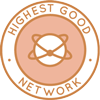 One Community is creating ecological models for thriving through open source Highest Good Network® software that is a web-based application for collaboration, time tracking, and objective data collection. The purpose of the Highest Good Network is to provide software for internal operations and external cooperation. It is being designed for global use in support of the different countries and communities replicating the One Community sustainable village models and related components.
One Community is creating ecological models for thriving through open source Highest Good Network® software that is a web-based application for collaboration, time tracking, and objective data collection. The purpose of the Highest Good Network is to provide software for internal operations and external cooperation. It is being designed for global use in support of the different countries and communities replicating the One Community sustainable village models and related components.
- Learn about our open source community collaboration and management software: The Highest Good Network
This week, the core team continued their work on the Highest Good Network PRs testing, confirming the fixed PRs and resolving several issues, for multiple pull requests, including the “Ready for Review” button interaction (#2254), validation for the Media Folder in the Quick Setup Tool (#2906), individual permission change tracking (#2868), badge deletion (#2976), Phase 3 Community Portal access (#2993), and the invisibility toggle permission (#2841). An issue with the Weekly Volunteer Summary Dashboard Components (#2974) was not fixed, and detailed descriptions with supporting images were provided. Additionally, they assigned eight new tasks to volunteers and recorded a new bug related to extra badges appearing when assigning a new badge, including supporting images and a recorded video demonstrating the issue. See the Highest Good Society and Highest Good Network pages for more on how this relates to ecological models for thriving. The collage below shows some of their work.
ALPHA SOFTWARE DEVELOPMENT TEAM
The Alpha Team’s summary, covering their work on the Highest Good Network software, was managed by Lin Khant Htel (Frontend Software Developer) and includes Nanguan Lin (Software Developer), Sheetal Mangate (Software Engineer), and Rupa Rajesh Bhatia (Software Engineer), covering their work on graphic designs for ecological models for thriving. This week, Lin reviewed and approved PR #3095, tested the codebase locally with all test cases passing, and continued to learn about the project. Lin also reviewed and checked the weekly summaries, photos, and videos submitted by Alpha team members and handled Alpha Team management duties, including task assignments and oversight. Developing ecological models for thriving teams requires careful attention to individual contributions and collaborative dynamics.
Sheetal focused on exploring the functionality of the weeklySummariesReport action. She worked on creating test scenarios for the updateOneSummaryReport, function with particular attention to validating scenarios when PUT and GET Request fails and code optimization by putting mock variables in the beforeEach block. which helps avoid repeating steup code. She completed pull request for the weeklySummariesReport action. Understanding ecological models for thriving is crucial for developing robust and resilient software systems. Rupa refined the multi-step form project by modernizing its user interface for better device adaptability. She leveraged component-based design to ensure a cohesive visual experience and customized various UI elements. To enhance interactivity, she integrated dynamic controls such as sliders, custom input fields, and toggle switches, all managed through modular state handlers. She also implemented asynchronous routing to facilitate seamless step transitions while maintaining user inputs. By thoughtfully structuring the user experience, Rupa aimed to create a digital environment mirroring ecological models for thriving, where user interaction and system responsiveness exist in harmonious balance.
Additionally, Rupa introduced adaptive logic to tailor form responses based on user actions and incorporated real-time data validation. She developed custom modules for digital signatures and user preference configurations. Collaborating with Sheetal, she evaluated the workflow and proposed process optimizations to improve efficiency. Moreover, she reviewed Lin Khant Htel’s project, offering insights and recommendations for technical and operational improvements. Her approach to development, much like the dynamics observed in ecological models for thriving, emphasized interconnectedness and responsiveness to change. Nanguan worked on lint fixes for the report component and resolved conflicts in his pull request involving more than ten files. He addressed failed test case results through refactoring and pushed the modifications to GitHub. Additionally, he investigated bugs raised by Jae and confirmed they were not related to his pull request. Learn more about how the Highest Good Network will measure and assist in ecological models for thriving in the Highest Good Network open-source hub. The collage below shows a compilation of the work from this team.
BINARY BRIGADE SOFTWARE DEVELOPMENT TEAM
The Binary Brigade Team’s summary overseeing advancements in the Highest Good Network software was managed by Anirudh Sampath Kumar (Software Developer) and includes Aaryaneil Nimbalkar (Software Developer), Geeta Matkar (Software Engineer), Sabitha Nazareth (Software Engineer), Samman Baidya (Software Engineer) and Sriram Seelamneni (Software Engineer). The Highest Good Network software is how we’ll be managing and objectively measuring our progress for ecological models for thriving through our social architecture, construction, production, and maintenance processes.
This week, Aaryaneil focused on writing test cases for user management actions in the front end. The tests covered multiple scenarios, including fetching user profiles, handling errors, and testing profile retrieval. He explored ecological models for thriving in the context of robust and resilient user management systems, considering how various components interact and contribute to a stable and functional whole. Additional unit tests were written for the user management component, addressing profile information retrieval, error handling, enabling and disabling user info editing, pagination changes, and initiating profile updates. Further test cases were developed for authentication actions, validating login flows for new and existing users, BM login handling, token removal, user resets, and profile fetching. Tests also verified token refresh mechanisms, user data updates, and specific error handling cases related to passwords and emails. A comprehensive approach to user management, like that being developed here, often draws inspiration from ecological models for thriving systems, recognizing the complex interplay of various components.
Anirudh worked on a bug affecting the “Team Member Tasks” section on the Tasks tab in the dashboard, where the section was cropped on the left and right sides. The issue was caused by changes from a previous pull request and had already been fixed in the development branch but had not yet been deployed to production. Understanding ecological models for thriving can provide insights into how software teams function and optimize their processes. Additionally, Anirudh reviewed and approved multiple pull requests, including PR 3047, PR 3049, PR 3056, PR 3057, PR 3065, PR 3093, PR 3094, PR 3095, PR 3103, and PR 3104. Geeta worked on resolving an issue with the “Generate Summary” button on the User Profile page. She modified visibility settings to ensure the “Generate Summary Intro” button was accessible for volunteer, admin, owner, and manager user roles. Understanding the ecological models for thriving of user engagement, she recognized the importance of broader access. A pull request was created to implement these changes.
Sabitha implemented the front end for adding and removing HGN team member access. She added a button to the left of the checkmark. She created a modal displaying a confirmation message: “Whoa Tiger! Are you sure you want to do this? This action is not reversible,” with options for confirmation or cancellation. A tooltip was included to explain the impact of the action, stating, “CAREFUL: Clicking this button removes a person’s access to Sentry, Slack, and GitHub. Then it deletes their Dropbox and all files in it.” Understanding the intricate dynamics of team access and its potential ramifications requires the application of ecological models for thriving.
Samman worked on his task default and collapsed views for the BM Dashboard page as part of Phase II tasks. After structuring the implementation, he encountered issues and worked on resolving them. Once the errors were addressed, he refined and finalized the code. During testing, he encountered a login issue that prevented access beyond the login page, preventing him from testing/previewing his changes even though it passed the suite test. He identified that the issue likely resulted from recent changes and is working to determine the cause. Understanding ecological models for thriving can offer insights into complex system interactions, such as those encountered during software development.
Sriram addressed bug fixes from code reviews, implemented a backend endpoint in a new pull request, and refined the filtering functionality in a previously submitted request. He also started investigating a permissions issue preventing owners from managing all user roles, reviewed default role-based permissions, and made updates to allow modifications. See the Highest Good Society and Highest Good Network pages for more on how this relates to our ecological models for thriving. View some of the team’s work in the collage below.
BLUE STEEL SOFTWARE DEVELOPMENT TEAM
The Blue Steel Team’s summary, presenting their work on the Highest Good Network software was managed by Nazanin Hashemian (Software Developer, Team Manager) and includes Ramakrishna Aruva (Software Engineer) and Supriya Sudini (MERN Stack Developer). The Highest Good Network software is how we’ll be managing and objectively measuring our process for creating ecological models for thriving through our social architecture, construction, production, and maintenance processes. This week, Nazanin worked on fixing a bug related to the task tracking system for resolved and closed tasks by updating components like Header.jsx, App.jsx, Routes.jsx, and UI.js. Additionally, Nazanin reviewed the update on the ‘Generate Summary Intro’ button visibility, confirming the changes were properly implemented. The project also explored ecological models for thriving within the team’s workflow.
Ramakrishna focused on resolving backend issues, addressing errors that impacted code functionality, and making necessary updates. Supriya improved the form’s user interface by adding Font Awesome icons, updating styling and colors for better consistency. These improvements represent a move towards ecological models for thriving within the user experience. She also enhanced its responsiveness, adjusting CSS to ensure it displays correctly across different devices and screen sizes. See the Highest Good Society and the Highest Good Network pages to learn more on how their work contributes to creating ecological models for thriving. See below to view images of their work.
CODE CRAFTERS SOFTWARE DEVELOPMENT TEAM
The Code Crafters Team, covering their work on the Highest Good Network software, was managed by Swaroop Udgaonkar (Software Engineer) and includes Anjali Maddila (Software Engineer), Ashrita Cherlapally (Software Engineer), Denish Kalariya (Software Engineer), Dhrumil Dhimantkumar Shah (Software Engineer), Humera Naaz (MERN developer), Muhideen Mustapha (Software Engineer), Pavan Swaroop Lebakula (Software Engineer), Pratyush Prasanna Sahu (Software Engineer) and Summit Kaushal (Backend Software Developer). The Highest Good Network software is how we’ll manage and objectively measure our process for ecological models for thriving through our social architecture, construction, production, and maintenance processes.
This week, Anjali, a full-stack developer, worked on an assigned task related to modifying the user interface. I began by understanding the codebase and the system’s workflow before creating a fork in the GitHub repository and initiating a branch named ‘User-names’. My work focused on the app.jsx file, where I updated the tab name from ‘User Profile – User name’ to just ‘User name’. Screenshots and a video of the changes were uploaded to a shared Dropbox link, and I also raised a pull request with the modifications, identified as PR number 3108. Ecological models for thriving organizations often emphasize adaptability and responsiveness to change, which was evident in Anjali’s systematic approach. Ashrita focused on implementing and enhancing the functionality of the Badge Management feature. She worked on refining the badge selection process, ensuring users can select multiple badges and see relevant statistics, including a pie chart displaying badge assignment data. She also worked on handling badge-user assignments, displaying badge data and assigned users in a clean, tabular format. Her approach to visualizing badge distribution mirrored ecological models for thriving communities, highlighting the interconnectedness of individual achievements.
Dhrumil worked on the 246 Phase 2: Reusables: Single Update task and encountered an issue, which he is in the process of resolving. He also selected a new task related to HGN Phase 3 and has started working on it while managing the ongoing work on the previous task. Ecological models for thriving inform his approach to juggling multiple projects simultaneously. Denish implemented functionality to record summary submission dates within the UserProfile model by adding a summarySubmissionDates field designed to store timestamps of user submissions. The update involved modifying the model schema to accommodate an array of dates, enabling automatic appending of new entries upon each submission. Existing data integrity was verified through backward compatibility checks, and validation tests confirmed consistent storage and retrieval of dates. Understanding these submission patterns may inform the development of ecological models for thriving within the user community. The change facilitates accurate tracking of user activity for audit purposes and aligns with requirements for future reporting or compliance workflows. Humera submitted a Pull Request for the “X hours for X week” feature, resolving an issue with the replaceBadge function to ensure badges are replaced with the higher streak when applicable. Additionally, she began working on the bell notification feature. Humera’s approach to feature development reflects an understanding of ecological models for thriving, where interconnected components contribute to the overall system’s health. She updated the header.jsx file to add a link for scheduling meetings under “Other Links”.
Pavan reviewed multiple pull requests and commits related to a previously reported issue. During the investigation, it was identified that an unintentional fix had already been made, specifically through a category filter update that resolved the issue. Additionally, attempts to replicate the user error were unsuccessful. The investigation of user error, informed by ecological models for thriving, proved unsuccessful, as attempts to replicate the reported problem yielded no similar results. Summit reviewed PR 1208 and identified a persistent issue where two-week streaks drop off in the database. They tested the code to replicate the problem and verified claims that users without a prior badge could not earn one, leading to ongoing work on a fix. Additionally, a reviewer reported being unable to view results through the frontend for an intangible time entry. Upon reviewing the provided video, he determined the issue stemmed from the entry not being marked as tangible, as intangible hours are not accounted for. The team explored ecological models for thriving to understand the interconnectedness of these system issues.
Swaroop worked on aligning team and people placement on smaller screens, adjusting layouts to match the changes from the previous week. He updated JSX files and modified a few CSS files to maintain consistency in alignment. As a manager-in-training, he reviewed his team’s work and followed up with team members who had not yet submitted their work. He considered ecological models for thriving as he evaluated the team’s current dynamics and potential growth areas. Muhideen implemented frontend enhancements to visualize badge assignment distributions through a categorical pie chart display, alongside a complementary table showcasing the top ten users associated with selected badges. The interface updates included theme-responsive adjustments to ensure consistent rendering across light and dark mode settings. Corresponding backend modifications were integrated to automate user list updates through scheduled cron job processes, ensuring data synchronization between visualization components and underlying user records. These improvements reflect an understanding of ecological models for thriving within a user community.
Pratyush worked on the attendance statistics page, replicating the design from Figma while addressing alignment issues and adjustments to the x-axis and y-axis of the bar graph. He developed the bar chart, planning the appropriate data for the x-axis and y-axis. Ecological models for thriving inform the very structure of effective data visualization as demonstrated in Pratyush’s work as an understanding of the principles. A pie chart and a bar chart were created, with the bar chart modified based on user class preferences, such as virtual, in-person, or recorded sessions. Additionally, he added a highlight section to showcase the most popular event and the maximum recorded attendance. See the Highest Good Society and Highest Good Network pages for more on how this relates to ecological models for thriving. View some of the team’s work in the collage below.
DEV DYNASTY SOFTWARE DEVELOPMENT TEAM
The Dev Dynasty Team’s summary, covering their work on the Highest Good Network software, was managed by Jatin Agrawal (Software Engineer) and includes Honglin Chen (Software Engineer), Mrinalini Raghavendran (Software Engineer), Nikita Kolla (Full Stack Developer), Nishita Gudiniye (Software Engineer), Shraddha Shahari (Software Engineer) and Zhifan Jia (Software Engineer). The Highest Good Network software is how we’ll manage and objectively measure our process for ecological models for thriving through our social architecture, construction, production, and maintenance processes.
This week, Honglin reviewed PR 1139 by testing all eight API endpoints using Postman. She also raised PR 3096 to fix a layout issue in the WBS tasks view by adjusting the button group alignment from an even distribution to a left-aligned row. In addition, PR 3098 addressed layout issues caused by a previous merge that affected the Projects page due to generic CSS selectors. Honglin’s work this week reflects a nuanced understanding of system design, informed by ecological models for thriving, which guides the structuring and maintenance of robust, adaptable complex systems. PR 3100 resolved a blank page issue affecting some user accounts when viewing profile pages and dashboards, which required modifications to multiple badge-related components, including Badges.jsx, FeaturedBadges.jsx, BadgeSummaryViz.jsx, BadgeHistory.jsx, and Badges.test.jsx. Honglin also reviewed phase 2 documentation and set up the backend development environment, while work began on phase 2 Lesson List button features under PR 3107. Understanding ecological models for thriving within complex systems informs our approach to software development, fostering robust and adaptable solutions.
Jatin worked on resolving the bug related to “Making bio pic additions from website pull only for newly published members” and addressing the “Fix Lead Team Badge auto-assignment” issue. For the first bug, a pull request (PR#1210) was created after backend changes were made to scope the cronjob to only affect members with published bios. However, the second issue could not be resolved due to its increased complexity. The auto-assignment feature for the Lead Team Badge is reliant on multiple app features, and a database model is inaccessible because no limits are imposed on the number of teams a member can join or the number of members in a team. A systems-thinking approach, grounded in understanding interconnected systems like those in ecological models for thriving, is crucial for addressing complex software challenges such as the auto-assignment feature. Mrinalini focused on enhancing the styling of the frontend form, starting with CSS and revisiting previously implemented Bootstrap components. She integrated the submit button states into the form and continued refining the design on day two, optimizing it to align with backend requirements. The principles of ecological models for thriving informed her approach to creating a robust and adaptable user interface. Additionally, she added more functionality, including drag-and-drop image functionality, a stylized date picker, and reordering and validating form elements. The week concluded with her wrapping up the frontend code changes, performing cleanup, and refactoring the code.
Nishita worked on understanding the requirements for the “Insights for Event Personalization” task and started implementing the frontend page based on the Figma mockup. She also worked on creating the front-end for the activity description/summary section, which will be merged with the “Event Registration” task. She reviewed PRs 2681, 2889, 2989, 3042, 3053, and 3061, which involved UI fixes for the HGN app, providing feedback and addressing review comments for the “Calendar View” and “Event Participation” tasks. Understanding ecological models for thriving organizations can provide valuable insights into how teams function and collaborate effectively. Nikita completed all features for the “Hours by Task” visualization on the Projects Reports page. Shraddha made changes to address a blank screen issue that occurred after deleting a task, debugging and testing the fix before preparing it for review. She also worked on resolving a bug related to selecting and saving featured badges, identifying the root cause to prevent recurrence. Understanding ecological models for thriving within software development helps teams build more robust and adaptable systems.
Zhifan worked on resolving an issue where a badge was not displaying on the summary page, which was traced to a typo during variable passing. Zhifan’s work exemplifies ecological models for thriving, which inform our understanding of complex system interactions. After resolving this, he investigated a bug related to time entries not appearing correctly in the dashboard tasks tab, adding debug logs to the frontend and backend to track values. This led to the identification of an endpoint that was returning wbsId and taskId as null, prompting modifications to ensure the correct population of these IDs when retrieved from the database. See the Highest Good Society and Highest Good Network pages for more on how this relates to ecological models for thriving. View some of the team’s work in the collage below.
EXPRESSERS SOFTWARE DEVELOPMENT TEAM
The Expressers Team’s summary, covering their work on the Highest Good Network software, was managed by Strallia Chao (Software Engineer) includes Jinda Zhang (Software Engineer/Machine Learning Engineer) and Shreya Laheri (Software Developer). This week, Jinda focused on enhancing test coverage by adding unit tests for the team.js action creators. A new test file, teams.js.test.js, was created under the appropriate directory, including tests for functions such as setTeamDetail, getUserTeamMembers, and fetchAllManagingTeams. These tests validated that the correct actions are dispatched, endpoints are correctly called, and data is properly fetched and dispatched. Error handling was also included to ensure that no dispatch occurs when axios.get encounters a 401 error. Inspired by ecological models for thriving, the team’s collaborative environment yielded enhanced test coverage for a more robust codebase.
Shreya worked on copying and consolidating questions from the HGN Questionnaire spreadsheet while researching better ways to display them on the dashboard. She attended the weekly team meeting to discuss progress, upcoming tasks, and project updates. Furthermore, she explored ecological models for thriving within the context of user interface design, seeking inspiration for enhanced dashboard visualization. Additionally, Shreya worked on developing the Admin Attendance page for Phase 3, making progress on its implementation and ensuring alignment with project requirements. Strallia hosted the weekly team meeting and reviewed backend PR 1207, which updates the Total Summaries Submitted component on the Total Org Summary page. She also developed the backend for the Blue Square Stats component for the same page, writing an aggregation pipeline to retrieve data. Strallia also tested the code with data from the database and researched MongoDB to support the development of the aggregation pipeline. See the Highest Good Society and Highest Good Network pages for more on how this relates to ecological models for thriving. See the collage below to view the team’s work.
LUCKY STAR SOFTWARE DEVELOPMENT TEAM
The Lucky Star Team’s summary of the Highest Good Network software, was managed by Anne Zhang (Software Engineer) and includes contributions from Chetan Sunku (Software Engineer), Koushica Bosadi Ulaganathan (Software Engineer), Nikhitha Kalinga (Software Engineer), Neha Bogireddy (Software Engineer), Srikanth Pusthem (Full Stack Developer), Shefali Mittal (Volunteer Software Engineer) and Vaibhavi Madhav Deshpande (Software Engineer). This week, Chetan received confirmation from Strallia that the previously reported bug related to the “Interact with Task ‘Ready for Review’” permission is no longer present and has been fixed. He also replicated the bug using different roles like Admin and Manager to verify its behavior before proceeding with further validation. Ecological models for thriving informed Chetan’s approach to testing the fix across various user roles, ensuring a robust and stable system.
Koushica worked on finalizing the dark mode implementation to ensure consistency across the product. She reviewed multiple UI components to identify inconsistencies in background colors, text visibility, and contrast levels, making necessary adjustments to align with the dark mode theme. This involved refining CSS variables, updating class-based styling rules, and modifying conditional logic to apply dark mode settings correctly across different sections of the application. Koushica’s work improves user experience by applying ecological models for thriving to design a user-friendly and accessible interface adaptable to varied lighting. She also addressed styling issues in dynamically rendered elements such as modals, dropdowns, and interactive components, ensuring they adapted properly without impacting usability. Additionally, she tested various user interactions to verify that transitions between light and dark modes functioned as expected without introducing visual disruptions. Neha focused on the Timer popout feature, with a pull request raised for its basic implementation. An issue with CSS not applying in the popout window was investigated but not resolved. Examining ecological models for thriving systems can provide insights into how design choices impact user experience.
A discussion with Jae addressed another bug related to formatting in the project bmdashboard, providing clarifications that allowed progress on this task. Time was also spent reviewing the phase 2 document to understand its basic structure and functionality. Shefali worked on the feedback provided by Jae for the auto-poster on Twitter/X. She added functionality to fetch scheduled posts and implemented logic to ensure that only posts that have not yet been published are visible to the user. Understanding ecological models for thriving within complex systems is crucial for effective project management. She is working on a front-end page to integrate this functionality and will commit the latest changes while continuing to develop additional features as discussed with Jae. Srikanth updated EditableInfoModal.jsx to resolve a PropType warning, making the loading prop optional to eliminate unnecessary warnings. In PermissionsManagement.test.js, API calls were mocked to prevent real network requests, avoiding ECONNREFUSED errors and improving test stability. Additionally, he created a new PR incorporating feedback from a previous review. He replaced real localStorage with a mock in the test environment, allowing for the simulation of different token states. The team explored ecological models for thriving to ensure the project’s long-term viability and growth.
He also mocked jwtDecode to control decoded token values, particularly focusing on expiryTimestamp to test the two-day expiration buffer logic. He also reviewed PRs that were flagged for being in the wrong folder and verified their placement. His contributions are documented in multiple PRs addressing warnings, API call mocking, Redux actions validation, and PR folder placement. He contributed to the project’s stability, informed by ecological models for thriving and their understanding of complex system interactions. Srikanth also ensured all weekly summaries and media files were prepared for submission before the deadline. Vaibhavi solved the version compatibility issue and worked on developing the frontend feature for creating an Event Rescheduling button. She added a new page in the project components named ReschedulePage.jsx. She encountered an access error while pushing the code on the branch and attempted to resolve the issue. Understanding ecological models for thriving, the team fostered a collaborative environment that allowed for rapid problem-solving, as seen in Vaibhavi’s approach to the access error.
Anne focused on testing and developing the issue with the manager account’s incorrect display of the dropdown menu under Other Links. She found that the bug was fixed in a recent commit on the main branch and is currently reviewing the code changes that contributed to the fix. Additionally, she identified that the BMHeader.jsx file was not being compiled, making debugging more difficult. She also managed the team Lucky Star’s reviews and pictures of the week. See the Highest Good Society and Highest Good Network pages for more on how this relates to ecological models for thriving. See the collage below to view the team’s work.
MOONFALL SOFTWARE DEVELOPMENT TEAM
The Moonfall Team’s summary, covering their work on the Highest Good Network software was managed by Newell Newell (Manager) , and includes Bhavya Prakash (Software Engineer), Calvin Liu (PR Team), Nikhil Giri (Software Engineer), Shashank Kumar (Software Engineer), Swathi Dharma Sankaran (Software Engineer), and Yili Sun (Software Engineer). This week, Bhavya reviewed the requirements documents shared by Jae and conducted initial research on the necessary designs. Collaboration with Meghna was planned following her outreach on Slack, and a meeting was scheduled with a team member to discuss and brainstorm design ideas. Notes were made on the next steps and approach for reference during collaboration. Additional research was conducted on Figma designs, and relevant studies were reviewed to support the design process. Bhavya explored ecological models for thriving within the user interface to ensure a balanced and sustainable design.
Calvin worked on resolving issues with the “One Community Work Breakdown Structure” hyperlink and the hover effect for the “Add Intangible Time Entry” button’s information icon. He also investigated inconsistent behavior in the update records modal that required a review of multiple CSS and JSX files. A custom tooltip implementation using ‘useState’ and event listeners replaced ReactTooltip to ensure correct display behavior. The hyperlink was fixed and the information icon was aligned with the button text. The tooltip displayed as expected, with work continuing on the update records modal. Exploring ecological models for thriving organizations, Calvin gained insights into system dynamics that informed his approach to problem-solving.
Newell planned social media integration using Postiz and discussed the implementation approach. He implemented a virtual list for dashboard tasks using React Virtual and developed backend features for searching users and tasks. He mapped out a migration plan to Azure Email Communication Services. Email templates were set up and coding was completed for the email editor. Research was done on replacing MailChimp with Azure Email Communications and initial implementation steps were taken. To ensure the project’s long-term viability, Newell considered ecological models for thriving, incorporating principles of adaptability and resource optimization. Nikhil worked on the Tool or Equipment Update form for Phase 2 of the HGN Software Development project and implemented input fields and validation for the Project, Tool or Equipment, Name, and Number fields. The form was made responsive for screen sizes over 400px, and HTML5 validation error messages were added. The submit button was enabled or disabled based on form validity, and a feature was added to clear fields when the cancel button was clicked. Understanding ecological models for thriving within software development lifecycles, he focused on creating a robust and user-friendly form.
Shashank worked on resolving extra space issues on the profile page by reviewing the layout and debugging a deployment error in CircleCI affecting the main branch. Various logs and configurations were checked. Swathi fixed a technical issue in the User Suggestions popup on a dashboard where “NaN” appeared before suggestion categories by updating data handling within the React component. A validation check was introduced to prevent similar errors and unit tests were conducted on the Task component to verify functionality. The team explored ecological models for thriving within their development process, seeking to create a more resilient and adaptable system. Yili fixed the “Edit Task” permission for managers and created a PR for the fix. Also, she began work on making tasks in the User Management component clickable hyperlinks, which involved testing related bugs on the development branch. See the Highest Good Society and Highest Good Network pages for more on how this relates to ecological models for thriving. Below is a collage for the team’s work.
REACTONAUTS SOFTWARE DEVELOPMENT TEAM
Reactonauts’ Team summary, covering their work on the Highest Good Network software, was managed by Vijeth Venkatesha (Software Engineer) and includes Haoyue Wen (Software Engineer), Jinxiong You (Software Engineer), Mohan Gadde (Software Engineer), Pallavi Thorat (PR Team O-Sh), Peterson Rodrigues (Full-Stack MERN Stack Developer), Rishitha Mamidala (Software Engineer), Saniya Farheen (Software Engineer), Sharadha Shivakumar (Software Engineer), and Xiyan Li. This week, Haoyue worked on the FAQ tool and focused on search functionality and management features. She developed a search function with an auto-suggest feature for commonly asked questions and implemented management capabilities for Owners and Admins to add or update FAQs. Understanding ecological models for thriving can inform the development of robust and adaptable systems, just as a well-structured FAQ tool supports a healthy information ecosystem.
Jinxiong resolved bugs in the HGN Apps and addressed a pop-up window issue related to the reset time button. She made a layout adjustments to fix display inconsistencies. Mohan improved the Admin user interface by refining alignment and consistency in the “Box on Right” layout. He fixed issues related to rendering, ordering, and column height. These enhancements contribute to ecological models for thriving within the application environment. Pallavi completed the registration page for the community portal and incorporated features such as event selection, real-time registration updates, calendar integration, and a commenting system, while using React hooks for state management. Peterson fixed a bug on the User Profile page that caused a blank screen instead of redirecting to the 404 page when an invalid user ID was entered. These improvements reflect a development approach grounded in ecological models for thriving, ensuring the platform’s health and user satisfaction.
Rishitha updated the “Add New Team” form by setting a character limit for team names and fixed error message behavior. She adjusted button alignment. She also added a “Created By” section in the “Add Material” form that automatically populated using Redux state. Understanding ecological models for thriving allows for a more nuanced approach to user interface design, ensuring that even small changes contribute to a more harmonious and efficient user experience. Saniya reviewed the dashboard for issues related to a previously fixed bug and monitored the system for regressions. She tested potential areas for further improvements while awaiting approval for her fix. Sharadha completed the frontend for the resource usage overview and updated the frontend folder structure. She configured routing and collaborated with the team to resolve implementation issues. Saniya and Sharadha applied ecological models for thriving to understand complex systems and ensure harmonious interaction of all components.
Vijeth Venkatesha managed team summaries and analyzed MongoDB for replicated data affecting performance. Xiyan developed a URL shortening service for the Highest Good Network application and implementing a URLService and URLController for handling API interactions. He managed URL history and ensured type safety and error handling with TypeScript. See the Highest Good Society and Highest Good Network pages for more on how this relates to ecological models for thriving. Below is a collage for the team’s work.
SKYE SOFTWARE DEVELOPMENT TEAM
Skye Team’s summary, covering their work on the Highest Good Network was managed by Preksha Welankiwar (Digital Marketing Manager and Admin) and Luis Arevalo (Software Engineer) and the team includes Yao Wang (Software Engineer). The Highest Good Network software helps manage and objectively measure the development of ecological models for thriving, focusing on social architecture, construction, production, and maintenance processes to build sustainable and thriving ecosystems.
This week, Luis worked on implementing the ability to send two warnings via both a button and a refactored API endpoint. He consolidated multiple endpoints into a single one, allowing it to accept either a single warning or an array of warnings while ensuring an email is issued when appropriate. Yao worked on the Reddit auto-poster, creating a workflow using JavaScript and HTML to test API functionality and contribute to ecological models for thriving. The current implementation allows posting to a subreddit through a custom HTML page and requires users to log in before making a post. See the Highest Good Society and the Highest Good Network pages to learn more about how their work contributes to ecological models for thriving. See below for the work done by the group.
SOFTWARE PR REVIEW TEAM A-H
The PR Review Team’s summary for team members’ names starting with A-H and covering their work on the Highest Good Network software was managed by Saumit Chinchkhandi (Administrative Assistant and Software Engineer). The Highest Good Network software is a foundation of what we’ll be using to measure our results of building ecological models for thriving. This week’s active members of this team were: Abdelmounaim Lallouache (Software Developer), Bhavpreet Singh (Volunteer Software Engineer), Carl Bebli (Software Engineer), Carlos Gomez (Full-Stack Software Developer), Eve Ye (Volunteer Software Engineer Intern), and Ghouse Shahe Meera Ziddi Mohammad (Software Engineer Intern). They reviewed all the Highest Good Network PRs (Pull Requests) shared in this week’s update. Learn more about how the Highest Good Network measures and supports building ecological models for thriving by exploring the Highest Good Network open-source hub. The collage below shows a compilation of the work from this team.
SOFTWARE PR REVIEW TEAM I-N
The PR Review Team’s summaries for team members’ names starting with I-N and covering their work on the Highest Good Network software was managed by Anoushka Hazari (Data Analyst). The Highest Good Network software is a foundation of what we’ll be using to measure our results for ecological models for thriving. This week’s active members of this team were: Ikechukwu Gbogboade (Frontend Software Developer), Kurtis Ivey (Full Stack Developer), Keying Guo (Software Engineer), Lalith Kumar (Software Engineer), Nahiyan Ahmed (Full Stack Software Developer) and Nathan Hoffman (Software Engineer). They reviewed all the Highest Good Network PRs (Pull Requests) shared in this week’s update. Learn more about how the Highest Good Network will measure and assist in ecological models for thriving in the Highest Good Network open source hub. The collage below shows a compilation of the work from this team.
SOFTWARE PR REVIEW TEAM O-Z
The PR Review Team’s summary for team members’ names starting with O-Z and covering their work on the Highest Good Network software was managed by Olawunmi “Ola” Ijisesan (Administrative and Management Support) and Samarth Urs (Administrative Assistant and Data Analyst). The Highest Good Network software forms the foundation for measuring our results in ecological models for thriving practices. This week’s active members of this team were Sai Girish Pabbathi (Software Engineer), Sharan Sai Marpadaga (Software Developer), Shengwei “Peter” Peng (Software Engineer), Srichand Medagani (Full Stack Developer), Vinay Vallabineni (software Engineer), Vivek Sharma (Software Developer) and Yiyun Tan (Software Engineer). They reviewed all the Highest Good Network PRs (Pull Requests) shared in this week’s update. Learn more about how the Highest Good Network measures and supports ecological models for thriving practices by exploring the Highest Good Network open-source hub. The collage below shows a compilation of the work from this team.
AND WE PRODUCED THIS WEEKLY UPDATES BLOG – CLICK HERE TO SUBSCRIBE
FOLLOW ONE COMMUNITY’S PROGRESS (click icons for our pages)
INVESTOR PAGES
GET INVOLVED
One Community Welcomes Aurora Yung Ching Juang to the Graphic Design Team!
Posted on February 2, 2025 by One Community Hs
One Community welcomes Aurora Yung Ching Juang to the Graphic Design Team as our newest Volunteer/Consultant!
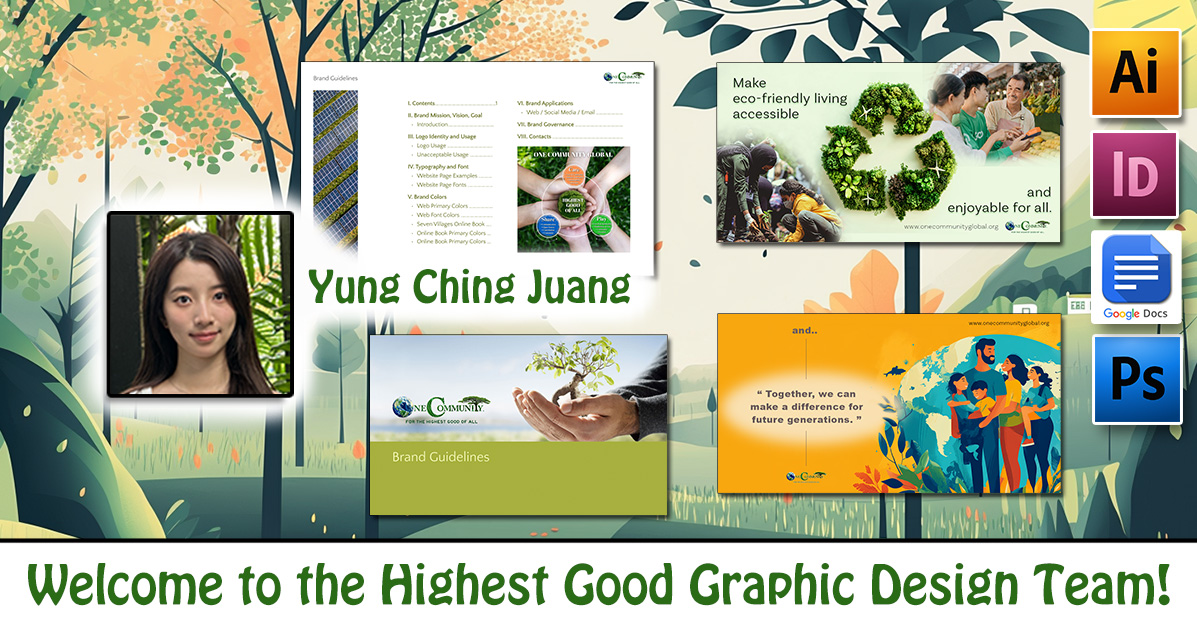
Aurora has five years of graphic design experience, specializing in branding, product design, and social media content creation. She is a graduate of Parsons School of Design in New York City and excels at creating humanized designs that improve behaviors and enhance visual communication through front-end and back-end development. She actively reviews pull requests, with over 40 reviewed, and plays a key role in developing features for the Management Dashboard and Form components. As a manager-in-training, Aurora conducts weekly team reviews, providing constructive feedback to drive team success.
WELCOME TO THE TEAM AURORA YUNG CHING!
FOLLOW ONE COMMUNITY’S PROGRESS (click icons for our pages)
INVESTOR PAGES
GET INVOLVED
Thanks for Your Contributions to Our Software Development Team Vatsal Mendpara!
Posted on February 2, 2025 by One Community Hs
One Community thanks Vatsal Mendpara for his contributions as a Volunteer/Consultant on the Software Development Team!
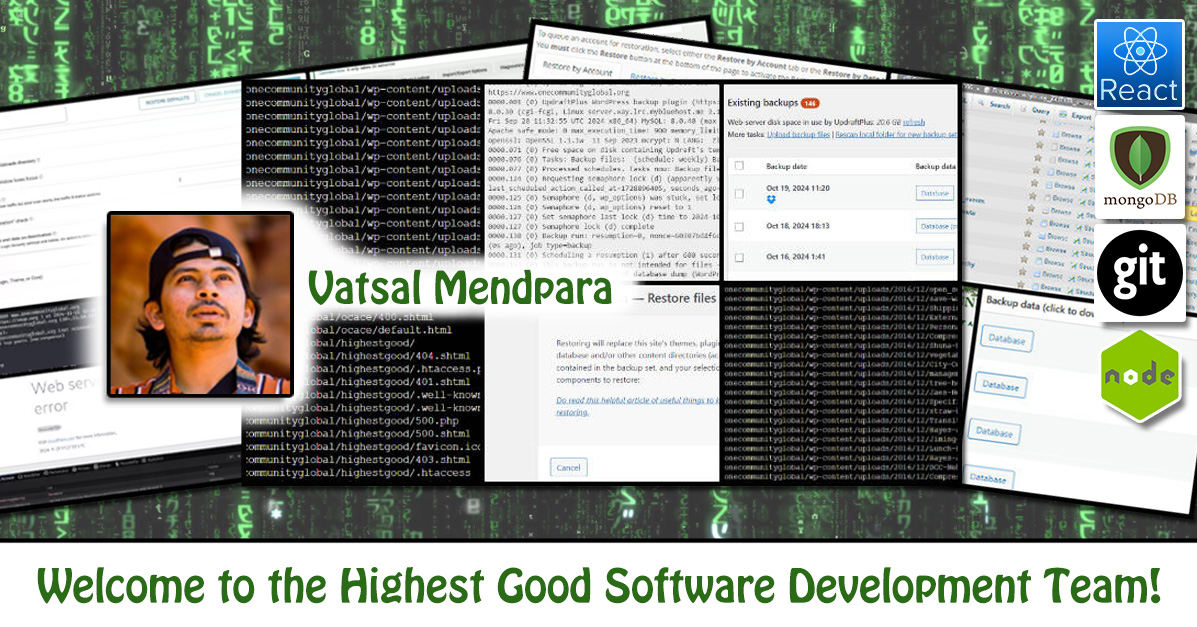
Vatsal is an experienced cybersecurity expert specializing in security engineering, web application security, incident response, threat analysis, and automation. With a deep passion for protecting sensitive data and fortifying web applications, he has been preparing for the OSCP certification to further enhance his penetration testing expertise. Dedicated to empowering organizations, Vatsal focuses on strengthening security postures and mitigating cyber risks effectively. While a member of the One Community team, Vatsal played a key role in safeguarding organizational infrastructure through the Highest Good Network Software. He implemented robust security measures and proactive threat management strategies, ensuring the integrity and resilience of systems.
WELCOME TO THE TEAM VATSAL!
FOLLOW ONE COMMUNITY’S PROGRESS (click icons for our pages)
INVESTOR PAGES
GET INVOLVED
One Community Welcomes Rudrani “Sravya” Mukkamala to the Engineering Team!
Posted on February 1, 2025 by One Community Hs
One Community welcomes Rudrani “Sravya” Mukkamala to the Engineering Team as our newest Volunteer/Consultant!
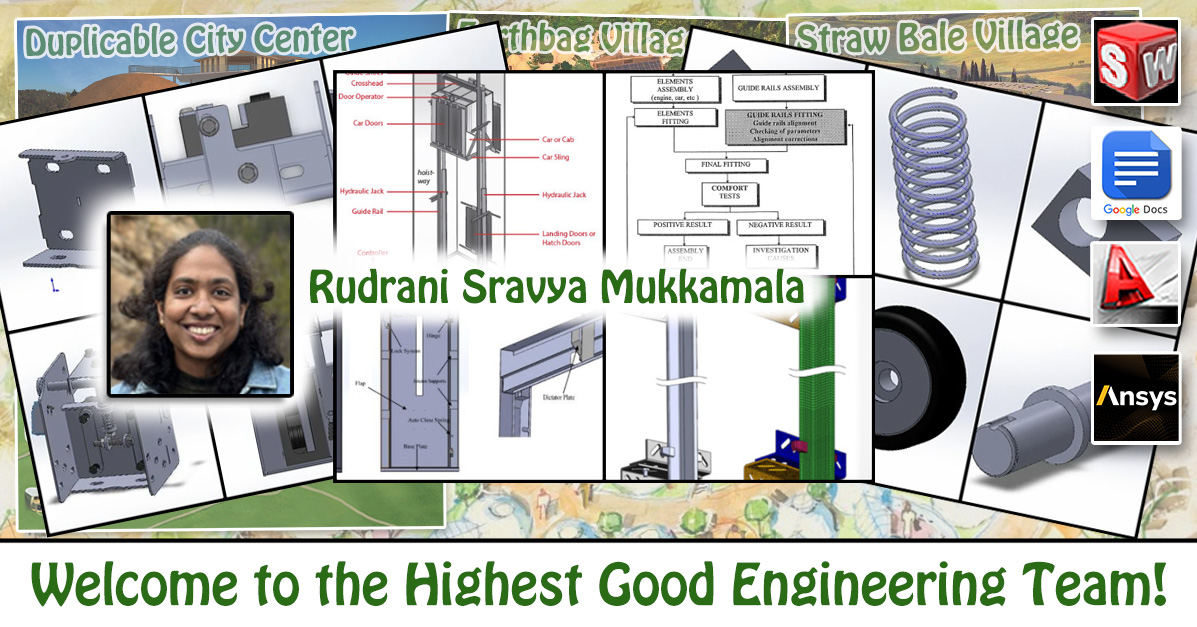
Sravya is a Mechanical Engineer with over 5 years of experience in design, structural analysis, and value engineering. Specializing in CAD and FEA tools like SOLIDWORKS, ANSYS, and ABAQUS, she has a proven track record of optimizing manufacturing processes, reducing costs, and enhancing structural efficiency. With a strong background in project management, standards compliance, and cross-functional collaboration, Sravya excels in delivering innovative solutions for complex engineering challenges. Her expertise spans designing various mechanical systems, performing advanced analyses, and mentoring aspiring engineers. As a member of One Community, Sravya is currently developing a DIY elevator system for the Duplicable City Center. After thorough research, she selected a hydraulic elevator for its ease of assembly and cost-effectiveness. She is now in the process of designing the elevator components, bringing her technical expertise and creative problem-solving skills to this exciting project.
WELCOME TO THE TEAM SRAVYA!
FOLLOW ONE COMMUNITY’S PROGRESS (click icons for our pages)
INVESTOR PAGES
GET INVOLVED
One Community Welcomes Denish Kalariya to the Software Development Team!
Posted on February 1, 2025 by One Community Hs
One Community welcomes Denish Kalariya to the Software Team as our newest Volunteer/Consultant!
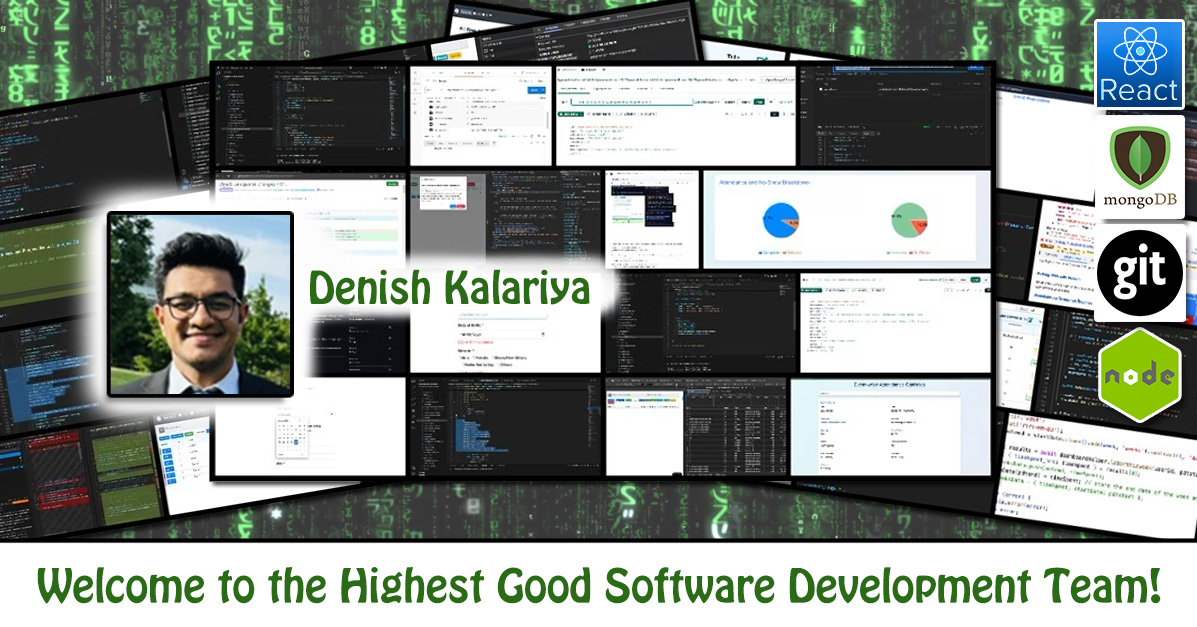
Denish has extensive experience in backend development and software solutions, with a focus on maintaining high-performing systems. He believes in creating scalable and efficient code to ensure seamless service delivery and reliability. As part of the One Community team, Denish continues to contribute to the Highest Good Network project by developing new features and resolving numerous backend issues. His efforts ensure the service operates continuously with minimal downtime and optimal performance, aligning with One Community’s mission of building sustainable and impactful solutions.
WELCOME TO THE TEAM DENISH!
FOLLOW ONE COMMUNITY’S PROGRESS (click icons for our pages)
 One Community
One Community
